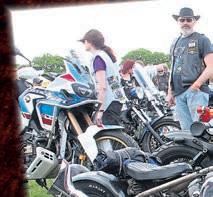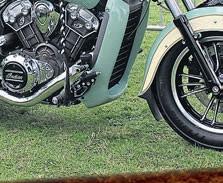








































































































































































































































I’ve done some miles this month. It might not be everyone’s idea of a good time, but I get a bit of a kick from a good day’s riding at this time of year. A few hours of sunshine and a stretch of dry Tarmac and I quite quickly forget about the hours of rain-sodden riding and the tentative first few miles on icy roads. I had a particularly good couple of days on Suzuki’s brilliant GSX-S1000GT, setting off from the Lincolnshire Wolds for St. Bees in the Lake District, before spending the next day blasting across the country through the Yorkshire Dales and the North Yorkshire Moors all the way to Robin Hood’s Bay (and then back home again via Pickering, the Humber Bridge and the ever inviting Caistor High Street back to MoreBikes HQ. The bike made it easy, offering all-day comfort and more than enough punch to induce plenty of smiles along the way. It’s a shame it doesn’t come with heated grips as standard, though.
I’ve also been out in the workshop, shuffling things around and making a bit of room to finally get close to a couple of project bikes that have been languishing under a fine layer of dust for far too long. One’s a lovely low-mileage Kawasaki KLR250 from the early 90s that set me back £300, that needs only a tiny bit of fettling to get it back on the road. The other’s a slightly less lovely (for now) Bultaco Sherpa 350 from 1978 that needs some serious attention to be returned to its former glory. Now I just need to make a start!
Also, I just wanted to take the chance to apologise to our pals over at Triumph East London. They helped us out with the R&G feature back in the December issue and we forgot to thank them! If you’re in the Romford area, be sure to drop in and say hello – they're great guys with a cracking selection of new and used bikes to browse.
KTM’s continuing its assault of updates across its extensive range of adventure bikes – and the latest to get tweaked for 2023 is its bonkers 1290 Super Adventure R.
The news follows on nicely from the big reveal of its updated 1290 Super Adventure S and as you’d expect, the more off-road focused R gets many of the same changes as its road-going sibling for the new year.
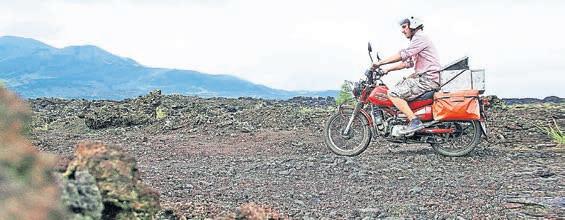

In addition to a new paint job and some Bridgestone AX41 tyres, the new 1290 gets a swanky new 7-inch colour display. It’s a proper bit of kit which allows you to access turn-by-turn navigation without having to faff about with the KTM smartphone app (though it does have all the usual smartphone connectivity if you want to make phone calls on the go).
Aside from that, it’s pretty much business as usual. The 1301cc V-twin engine (with 160hp and 138Nm of torque), 23-litre fuel tank, 15,000km service intervals, manually-adjustable WP suspension all remain, and there’s the usual suite of sophisticated electronics which includes traction control, wheelie control, cornering ABS, and multiple riding modes.

It’s a cracking package and KTM didn’t need to mess around with the bike too much, so a few small tweaks and a few extra goodies should be plenty to convince adventure aficionados to give the big 1290 Super Adventure a serious look if they’re in the market for something that’s capable both on and off the road. And it’s already available in dealers for the princely sum of £17,299.
The resurgence of another British brand is well underway, with the arrival of three new bikes under the historic Dot banner. There’s the Dot Demon scrambler, the Reed Racer café racer and the new limited edition Street Fighter. From its home at the National Centre for Motorsport Engineering in Bolton, the Street Fighter’s been developed with the help of Guy Martin and Steve Parrish. It’s powered by the same 650 parallel twin as Kawasaki’s Z650 naked and Ninja 650 (which kicks out 67bhp and 47lb-ft of torque), gets Brembo brakes, Showa shocks and a whole host of handmade parts. The limited edition machine won’t come cheap though, and is expected to be priced around the £25,000 mark.
Nathan Millward’s just launched a brilliant new event that aims to show people you don’t have to spend a fortune to have a proper adventure.
Nath made his name by riding a Honda CT110 Postie bike back to the UK from Australia, and has since carved out an enviable reputation as a respected journalist, top tour provider and all-round adventure guru.

To take part in The Grand Challenge all you’ve got to do is buy a bike for less than a grand (or use one you already own), sign up for free, and

then get out on the road and trails to win points for your adventure exploits. We reckon it’s a great idea… anything to motivate people to get out on
their bikes is a good thing in our book.
If you want to find out more, visit: www.dorothysspeedshop. com
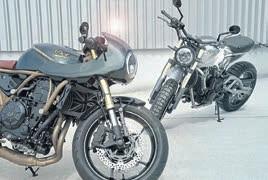
Slotting into the increasingly crowded middleweight adventure bike market, Suzuki’s V-Strom 800DE looks to be a winner with its 776cc parallel twin, 84hp motor, fully adjustable Showa suspension and off-road riding mode. But up until now, we didn’t know how much we’d have to splash out to get our hands on one.
Thankfully, the factory’s just announced that it’ll come in at a respectable £10,499. That means that the new Suzuki is cheaper than KTM’s 890 Adventure, Ducati’s DesertX and Aprilia’s Tuareg – although it’s not as cheap as the £10,100 Yamaha Ténéré 700. The only question that remains is how much Honda’s asking for its newly-released Transalp?
What’s been happening this month...
Another month and another set of spy shots of a new Royal Enfield. This time they're of a roadster powered by a new water-cooled 450cc engine.
Leaked images of a previously unseen roadster suggest that Royal Enfield could be gearing up to launch a range of bikes built around its new watercooled 450cc motor.
The Himalayan’s been a massive success for the Indian firm, but with its archaic air-cooled engine, there’s no doubt it’s getting a bit long in the tooth. That’s why it came as no surprise when we heard the news there was a new engine in development for the much-loved back-to-basics adventure bike. But it’s looking like the engine that’s earmarked for the next generation
Himalayan could be the basis of at least one more machine.

Recently released spy shots published by Cycle World show a compact roadster with what looks like a 450cc water-cooled engine – adding fuel to the fire stoked by leaked documents which detailed Enfield’s plans for new bikes across its various platforms.


While there’s been no official word from the factory on the newest machine, close inspection of the images does allow us to glean a few key details about the upcoming bike. As you’d expect, there’re plenty of
KTM’s much-loved LC8c engine could be about to get a massive overhaul. Patents filed by KTM's Chinese partner CFMoto suggest that the current 890cc unit could be expanded further to 990cc. Some serious work has gone into making it happen – and it looks like we won’t have to wait too long to see it in action, as it’s already being tested in the upcoming 990 Duke and RC 990..

similarities between a few of Enfield’s other machines, with the 300mm single disc front brake with sliding calliper near on identical to that of the Scram 411, and the steel tubular frame remarkably similar to that of the anticipated Himalayan 450. Unlike the new adventure bike, the roadster gets a standard telescopic fork up front, while at the rear there’s a single shock absorber connected directly to a cast-alloy swingarm.

At this stage, that’s about all we
We’ve been telling you for years about Harley-Davidson’s plans to move into the small and midsize motorcycle market. We’ve brought you leaked documents, concept art, details of donor bikes and more – and yet there’s still been no official news about what’s to come. Until now. We’ve finally got a look at the new ‘X350’ which has been built collaboratively by Harley-Davidson and its Chinese partner Qianjiang. Although it’s dramatically different in looks to the original leaked images of the bike, it’s pretty damn close to what we’ve seen more recently, and it’s not all that dissimilar to bikes from Qianjiang’s other partner, Benelli. The Harleys and the Benellis come kitted out with nearly identical tubular steel frames, stressed member engines, chunky forks, and similar retro styling. The big question now is when we’re actually going to see one of the new Harley-Davidsons in the flesh… and also, if they’re actually going to make it on to British shores. At this stage it’s still possible that H-D will use these bikes to grow its sales in Asia, where big bikes are less in vogue. Thankfully, it’s looking like we won’t have to wait too much longer to find out.
know – and realistically, we’re going to be waiting a while to find out more as Royal Enfield’s only just revealed its 2023 range to the world. And there was no news about an upcoming 450cc range at the time…

That means we might end up having to wait until 2024 to get an official lowdown on the latest batch of bikes from the ever-growing Indian firm, though chances are there will be plenty more spy shots and leaked documents in the meantime.

Leaked documents confirm that Harley-Davidson is gearing up to release a new Nightster S – and although the details are scarce, we have got our hands on an image of the bike.
The big differences from the standard Nightster include the addition of a small pillion seat, new wheels, and a swanky new paint job. Hopefully, we won’t have to wait too much longer to find out more, as H-D’s got a launch event planned for later this month.
Following the launch of the CL500, Honda has just announced its going to be producing a slightly smaller CL300 in China – and we’re hoping it makes it to British shores very soon. Powered by a 26bhp, 286cc engine that’s capable of 78mph, the plucky little street scrambler would be a great addition to Honda’s growing range of small-capacity machines.
It looks like we’re finally getting closer to seeing the long-awaited small-capacity Harley-Davidsons in the flesh. Here’s what we know.
“It’s not all that dissimilar to bikes from Qianjiang’s other partner, Benelli”




















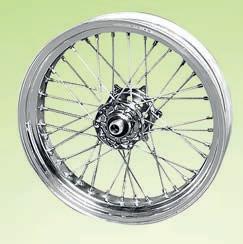





Sinnis Motorcycles has just announced a brand-new partnership with the Desert Rose Riding Academy – and together they’ve launched the UK’s first learner-friendly adventure riding school. Riders will take to the trails on board the tried and tested, budget-friendly Sinnis Terrain 125 under the guidance of four-time Dakar legend Patsy Quick and Redbull Romaniacs racer Harry Michael. They’ll be on hand to offer some world-class coaching on the fundamentals of riding an adventure bike off-road, in Desert Rose’s dedicated training facility in the East Sussex Woodlands. It’s meant to be a cracking place to ride, with over 80 acres to play on, which offer a wide variety of different trail types from wide, graded trails through to more challenging single track.



The training is broken down into easy-to-digest sections, with the fundamentals taking priority to start with. You’ll be offered guidance and advice on body position, visibility and controls, before progressing on to more advanced adventure skills, including rear-wheel slides and how to pre-load suspension to cross obstacles. But the good news is that the training is tailored to the individual, with the main aim of the day being to help riders build up their off-road riding confidence and get the most out of the day. Sounds good, right? And the Terrain 125 is the perfect tool for the job; easy to manage, capable and plenty resilient enough to take a bashing without being intimidating. And you only need a CBT to get involved!
If you want to know more about riding at the Desert Rose Riding Academy, visit www.desertrose.academy

























British firm Triumph has announced that it’s looking at ways to run its Grand Prix race engines on more sustainable fuels.
Following the news that MotoGP bosses plan to run ethanol-rich E40 fuel in Moto2 by 2024, Triumph has set up a dedicated testing programme for environmentally friendly petrol.

It’s a big step towards a greener future from the Hinckley-based factory – but a necessary one,
too, considering that Dorna has plans to reduce CO2 emissions in Moto2 racing even further, and is aiming to introduce an E100 blend by 2027. Now Triumph has the unenviable task of ensuring its Street Triple-derived 765cc triple motor can work just as well with ethanol-rich fuels.
But it sounds like that’s just the start, and it might not be too long before we can all get our hands on bikes powered by these cleaner, greener fuels.
Speaking about the news, Steve Sargent, Triumph’s Chief Product Officer, said: “Ultimately, our aim is always to take all the learnings we gain from racing to make our road bikes even better, which of course encompasses not just performance but also their impact on the environment. I can tell you that everybody here at Triumph is very excited to be involved in such significant developments at such a pivotal moment in motorcycle history.”
Bering’s just revealed a new textile suit that’s made from recycled plastic taken from the sea. It might sound crazy, but the idea is nothing new. Since 2007 some big firms (including Nike and North Face) have been using innovative Repreve material to make quality gear that’s good for the environment. And now Bering’s getting in on the act.
Repreve’s made by grinding up plastic bottles, cleaning them, flaking them, melting them down, and then using the material to form
fibres which can be spun into yarn. And that’s the stuff that makes up 70 per cent of Bering’s new Freeway jacket and trousers. There’s plenty of other good stuff included with the textiles, like Bering’s Shelltech
Extreme, Alpha Level-1 armour throughout, and Bering’s BWTech fixed inner membrane, so you can rest assured that the kit will be well up to the job of keeping you warm, dry and well protected – it’s just that you’ll be helping to do your bit for the environment at the same time. For more information on the kit, visit: www.bikerheadz.co.uk
Italian helmet specialist Airoh has revealed the world's first integrated airbag helmet for bikers. Airbag systems are nothing new in the world of motorcycling, but this is a serious step forward in ensuring bikers are safer than ever. Created in collaboration with Swedish safety firm Autoliv, the helmet inflates from the crown during an accident using an
integrated gas generator, to provide much greater energy absorption than a conventional helmet.

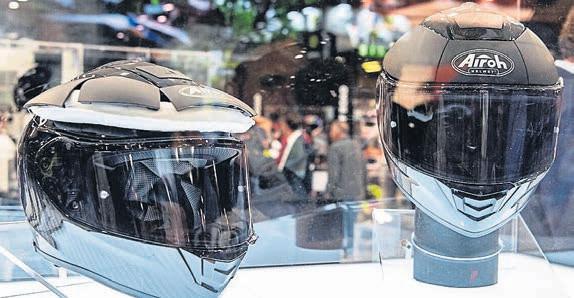

One of the biggest challenges Airoh faced was ensuring that the helmet met stricter ECE22.06 helmet safety standards (both before and after an airbag deployment). To do that, it’s been using virtual crash simulations and physical impact testing to fine tune the helmet over the last three years.
The helmet’s still just a prototype at this stage, but we’re hoping that this seriously sophisticated safety technology could be making it to market in the near future. Particularly when you consider that Autoliv reckons that the lid can reduce the probability of serious injury due to a skull fracture by half (from 60% to 30%).
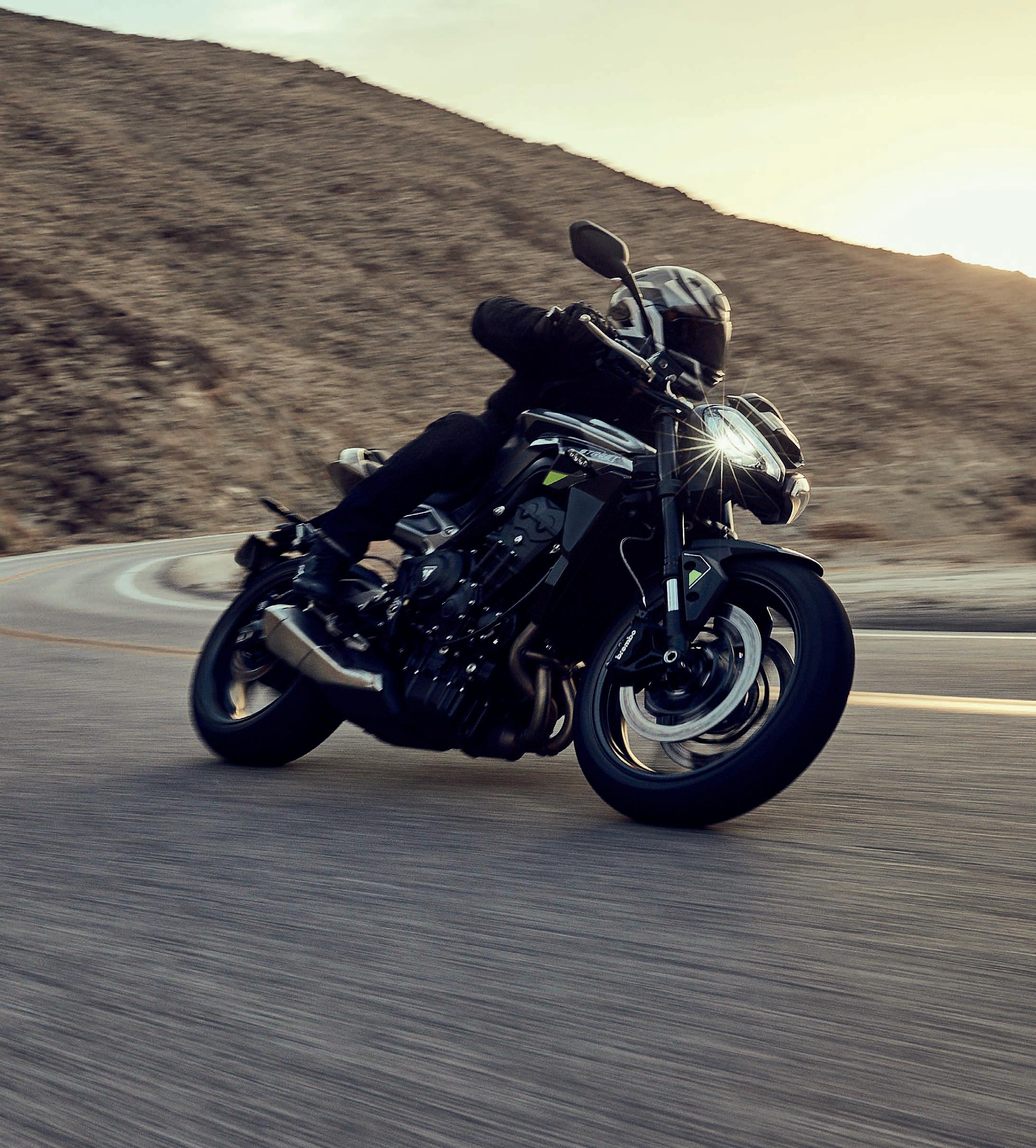


























February 11-12 / Telford International Centre / www.classicdirtbikeshow.co.uk



If you’re into 60s scramblers and twin shock trials bikes, there’s only one place to be this February: The Classic Dirt Bike Show sponsored by Hagon Shocks.
The UK’s biggest classic off-road show is a haven for those who like riding on the rough stuff.
Admire some beautifully prepared off-road machines, while browsing the wares of the hundreds of traders on hand, with spares, parts, accessories, kit and bikes to suit every budget – and there’s also a chance to bag a bargain at the daily autojumble.

That’s not all. Three-time world champion and 80s and 90s racing icon Dave Thorpe has been confirmed as the star guest for the show. As Britain’s most successful motocross racer, with three 500cc World Championships, a Veteran’s World title and multiple British Championships to his name, there’s no doubt Thorpe will have plenty of fascinating tales to tell throughout the weekend.
For more details about the Classic Dirt Bike Show sponsored by Hagon Shocks (and to save £2 on discounted advance tickets), visit the website.



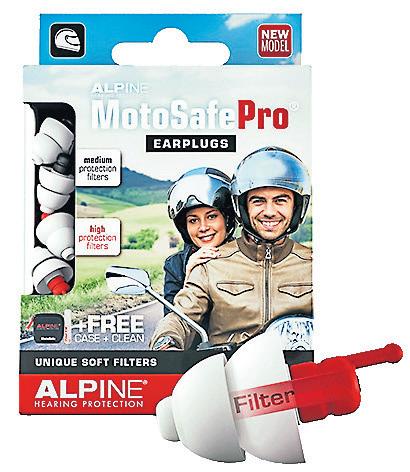
£990 | www.forcitehelmets.com
The Forcite MK1S is the lightest smart helmet on the market at 1500g. It has ECE 22.05 and DOT certification and is one of the only streetlegal smart helmets available. The helmet’s patented technology is housed within a handlaid carbon fibre shell.
Features include high-end in-helmet audio powered by removable, 40mm Harman Kardon speakers. The speaker system is paired with omni-directional dual microphones tuned for vocal clarity and wind reduction for riders to take calls. You can also use the microphone to voice over video taken with the in-built camera.


£140 | www.weiseclothing.com
Available in a wide range of sizes to fit men and women, Weise Ridge jeans bring the benefits of riding in denim to everyone.
Lined with abrasionresistant aramid fibre, with CE approved armour at the knee and hip, and seams that are either double- or triplestitched, Ridge jeans are tough enough to be rated AA for protection.


They come in a choice of classic Black or Blue colours and in an extensive range of sizes to accommodate most riders (30in-42in waist for men, and women’s sizes 8-22). The men’s jeans are also available in regular and short leg lengths.

£77 | www.halleyaccessories.com
Taking inspiration from vintage army gear, this helmet bag provides greater functionality with added pockets for storing belongings such as documents, gloves and keys. It is conceived with resistant fabric and a thick, soft velvet lining to prevent scratches and abrasion. Leather details have been added for a classic touch. Solid ropes are used as straps, allowing riders to wear the bag as a cross-body bag or as a simple backpack. The helmet bag is lightweight, flexible and easy to wash. Availability is in four colours.


£650 (jacket) £500 (trousers) | www.bikerheadz.co.uk

Rukka’s new Comfo-R suit is made from Gore-Tex, with abrasion-resistant Cordura reinforcements in key areas and a full set of CE-approved armour. The suit is waterproof, and has a detachable thermal lining in both garments and a connector zip and crotch strap to link them together. The jacket has two outer pockets with zippers, and two water-resistant inner pockets, while the trousers have two zipped pockets. Both the jacket and trousers have vents to allow air to circulate. The suit comes with a six-year warranty.
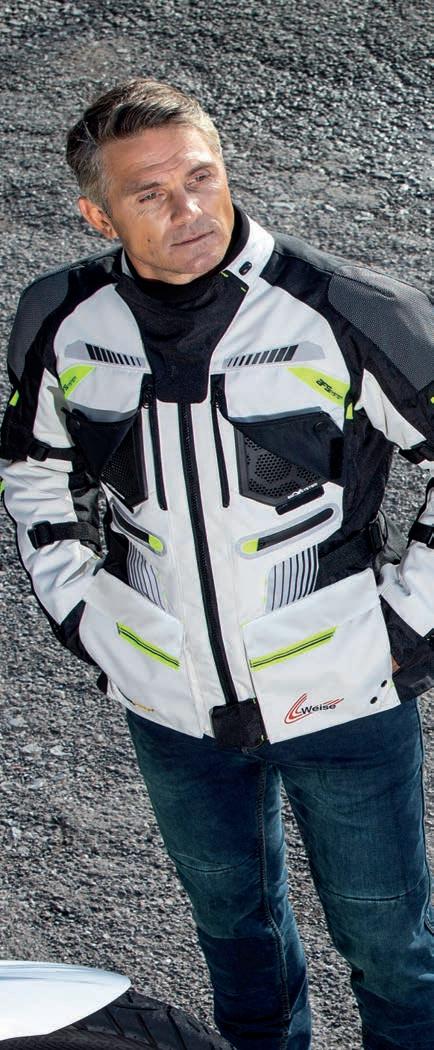
We love a bit of trivia here at MoreBikes. No matter whether we’re at a pub quiz with a beer in one hand and a pencil in the other, or being questioned by our mates when we’re stood around at a bike night, there’s something about knowing the answer to an unexpected question that gives us a
nice fuzzy feeling inside. And if we don’t know, then there’s a good chance we might learn something. That’s cool, too. That’s why we’ve decided to introduce a regular quiz section sponsored by our good pals at Fowlers (who’ll be supplying the prizes).
We’ll be asking you questions about all manner of two-wheeled stuff,
Which firm did Kymco build bikes for through the 60s, 70s and 80s?
Which Italian manufacturer has a factory on the banks of Lake Como?
When did Segway first launch its funky two-wheeled ‘personal transporter’?
Nathan Millward rode which bike from Australia to the UK?
When did The Dragon Rally first take place?
pushing your memories to the limit and asking you to dig deep to try and remember all manner of strange stuff from right across the world of bikes. It’s a chance for you to show off your infinite two-wheeled wisdom and be in with a chance of winning some cool prizes, or if not, learn a few things that you might not know.
What’s the less-than-flattering nickname of BMW’s K100?
How much power did Yamaha’s first generation TZ500 have to play with?
When was Suzuki’s venerable V-Strom 650 first launched?
Which historic Mancunian firm revealed three new models in 2022?
Which brand just revealed the world’s first integrated airbag helmet?
Cold hands are horrible. But you won’t have to suffer much longer with these all-weather gloves from Weise. The Montana is lightweight without compromising on warmth, offering a full-grain leather and polyester construction, a Hipora waterproof, windproof and breathable membrane and a 150-gram Thinsulate Supreme inner liner. For protection there’s TPU knuckle and finger armour, padded fingers and dual-layered leather in critical zones. There’re also wrist and finger stretch panels for added flexibility; an adjustable wrist strap; Chamude palm overlay for improved grip; 3M Scotchlite piping for added night-time visibility; and an integrated visor wipe on the finger. What more could you need?

To be in with a chance of winning, all you’ve got to do is jot the answers down on the entry form, and send it in using the details provided. We’ll then pick the winner from an upturned helmet crammed with correct answers and that person will be sent a brandnew pair of Weise Montana all-weather gloves – so no more cold hands! It’s that simple. So, what are you waiting for? Get cracking for the chance to win. Good luck!
Did you get
right? Mick Doohan, Bob McIntyre, 100 Million, 1981, Yamaha XT500, 1987, 1901, Germany, Bud Ekins, a tomato can
It’s time to get out your pens and pencils and put your grey matter to the test.
We love to see what you lot are riding – and we know the rest of you like it, too. It’s just like pottering around a bike night and checking out what’s been brought out for a ride. Now we’ve decided to bring the bike night to you, asking readers to send us photos of their pride and joy for the world to see. Here’re some of our top picks from the last month.

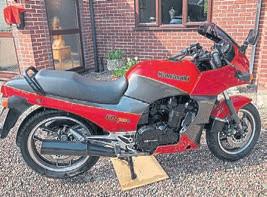




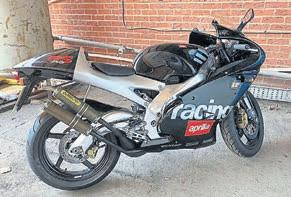


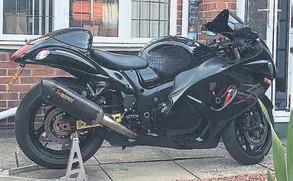
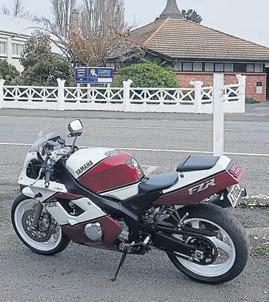






































 In partnership with Forcefield Body Armour
Aaron Adcock’s mint Yamaha FZR. Quality bit of kit that looks as good today as it did back then.
Another ’Busa. But this time it’s James Kilgar’s and it’s a new one. It looks mean in all-black and we’re sure that Akrapovic exhaust sounds beefy.
Garry Wells’ gorgeous Honda CBX looks absolutely immaculate.
Neil Alger’s Yamaha FZR 400 Genesis from 1986. It’s a lovely thing. He got it back on the road in 2022 and has had mental fun blasting around on it. It took years to get it like this – and it definitely looks as though it was worth all the hard graft.
Darren Groucutt’s tidy Aprilia RS250. We bet he has some fun on this little screamer.
Jezz Wainwright’s lovely Yamaha TDM 850. We’re a big fan of these. It’s the bike that, arguably, marked the beginning of the ‘adventure sports’ category, so we’ve got a lot to thank it for.
George Hutchison’s Suzuki Hayabusa which he’s had for a couple of years. It’s a very early one – production number 1800. It’s definitely one to hang on to.
Suzuki’s forgotten superbike. Neil Tiffin’s Suzuki TL1000R looks lean, mean and ready to go. We love it.
Dougie Mason’s much-loved Yamaha RD350. He’s owned it for 23 years and it still makes him smile.
Steve Geary’s Kawasaki GPZ900R from 1984. It was a great bike then and it still is today.
In partnership with Forcefield Body Armour
Aaron Adcock’s mint Yamaha FZR. Quality bit of kit that looks as good today as it did back then.
Another ’Busa. But this time it’s James Kilgar’s and it’s a new one. It looks mean in all-black and we’re sure that Akrapovic exhaust sounds beefy.
Garry Wells’ gorgeous Honda CBX looks absolutely immaculate.
Neil Alger’s Yamaha FZR 400 Genesis from 1986. It’s a lovely thing. He got it back on the road in 2022 and has had mental fun blasting around on it. It took years to get it like this – and it definitely looks as though it was worth all the hard graft.
Darren Groucutt’s tidy Aprilia RS250. We bet he has some fun on this little screamer.
Jezz Wainwright’s lovely Yamaha TDM 850. We’re a big fan of these. It’s the bike that, arguably, marked the beginning of the ‘adventure sports’ category, so we’ve got a lot to thank it for.
George Hutchison’s Suzuki Hayabusa which he’s had for a couple of years. It’s a very early one – production number 1800. It’s definitely one to hang on to.
Suzuki’s forgotten superbike. Neil Tiffin’s Suzuki TL1000R looks lean, mean and ready to go. We love it.
Dougie Mason’s much-loved Yamaha RD350. He’s owned it for 23 years and it still makes him smile.
Steve Geary’s Kawasaki GPZ900R from 1984. It was a great bike then and it still is today.
Q
Help! I do not know what to do. I am a food delivery rider and I spend most nights whizzing around my local town on my Bandit to earn some extra cash. Five months ago, I pulled up outside a block of flats to drop off a chicken chow mein, a king prawn curry and half a crispy duck. Unfortunately, it was a massive complex and by the time I found the flat (the person who ordered did not give very good directions) and got back to my bike it was about 25-30 minutes. When I got there, I found two police officers taking photos and making a note. One officer basically laid into me whilst the other stayed quiet. Long story short, I had left my bike on a corner of a junction which had double yellow lines. I explained I did not mean to be long, but it had taken me ages to find the flat and this wasn’t my fault, but that of the lady who ordered. The angry officer was resolute and told me it was dangerous as it meant people had to swerve around my bike to get out of the junction and if I disagreed, I could tell the court. I then got some court papers that said I had been summoned for ‘The offence of leaving a vehicle in dangerous position, contrary to s.22 of the Road Traffic Act 1988’. Last week I went to court and argued this wasn’t my fault and I was innocent. However, the magistrates disagreed
and gave me three penalty points and a massive fine to pay. What can I do? I can’t see why I should get done for this. I was just doing my job.
AFirst things first, you do have a right to appeal. However, the general rule is you have to lodge your appeal within 21 days of the conviction. So if you are going to do that, do not hang about, get your appeal form in (you can find this online or the court will give you one if you ask). The real issue is whether you should appeal. So you are aware, the actual law states that ‘If a person in charge of a [motorbike] causes or permits the [motorbike] …to remain at rest on a road in such a position or in such condition or in such circumstances as to … involve a danger of injury …to other persons using the road, he is guilty of an offence’. Therefore, whilst I get you were doing your job, if you left your motorbike parked on a corner of a junction with double yellows and other drivers had to swerve around it to get out, etc., I can see why you were found guilty and appealing the actual conviction would be a waste of time. However, arguably you could look to appeal the sentence because the three penalty points you got are ‘discretionary’, not mandatory. In other words, if you appeal, you could end up with no
The MB legal column

The firm deals with personal injury claims and its sister company, Motor Defence Solicitors, deals with all the motoring offences. White Dalton lawyers have a vast knowledge of bike law, and
they have full bike licences, too. They don’t act for insurance companies or the prosecution. White Dalton is Britain’s premier specialist motorcycle law practice, and if its professionals don’t know the answer to your question, there probably isn’t one. Don’t rely on the advice from your insurance-appointed solicitor, get proper independent advice.
penalty points (but you would still have to pay a fine, etc.). I would just add that as a general rule, where any prosecution is challenged there is a potential for increased court and prosecution costs. These would only normally increase if the matter resulted in an appeal that you subsequently lost.
QIn March 2022 my Aprilia Pegaso was serviced by a garage in England. Around eight weeks later (May 2022), whilst I was riding home after a long European tour (I was back in England at the time of the accident), the throttle stuck open. This resulted in me crashing at around 70mph on a straight road. I cannot remember why I fell off, only that the throttle had got stuck on before I did. I did not want the insurer looking at the bike too closely in case they did not pay out for it. Thankfully, they didn’t and I got paid out for the bike. Thereafter it got sold by them by way of an online auction in June 2022. About a month ago, the man who purchased it via the auction tracked me down to get some more info on the bike. He also told me that in his opinion a cable had been wrongly routed when he looked at it, and that caused the throttle to stick open sometimes. I now want to bring a claim against the garage who serviced
For road traffic offences, call the Motor Defence solicitors on 0800 280 0912.

For non-offence cases, call White Dalton motorcycle solicitors on 0800 783 6191.

If you need advice on a biking-related legal question or query, email mail@whitedalton. co.uk. The best Q&A will be published in MB, in confidence, of course.
my bike for causing the accident. I broke my ankle at the time and trashed my kit. What do you think?
AAs for bringing a claim, it will be useful for you to know the legal test before we go any further. In England and Wales, you as the claimant has to prove on the ‘balance of probabilities’ that:
1. The garage has been negligent
2. Because of that negligence, you have suffered a loss, or will suffer a loss.
If you had spoken to me at the time of the accident, I would have advised you to keep the motorbike and get it inspected by a court compliant engineering expert. If s/he confirmed that the throttle was sticking open due to the work done by the garage, then you would have good evidence to pursue a claim. However, as the ‘evidence’, i.e. the bike, passed through many hands and was sold, I am of the opinion you would struggle to prove ‘on the balance of probabilities’ that the garage was to blame for your accident. In simple terms, you no longer have the evidence to prove your case in my opinion. Therefore, I am afraid you don’t have a case and you would lose at court.

Our specialist motoring solicitor Andrew Prendergast guides readers through their legal trials and troubles









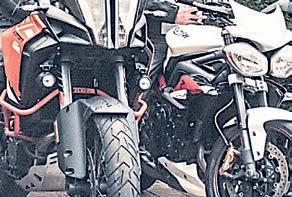






































Moto Guzzi’s future’s looking sweet, with a brandnew engine, electronic suspension and adaptive aerodynamics for its all-new sport tourer

Back in the 1990s when sportsbikes were king, sport tourers were de rigueur among a certain type of rider.
But with the arrival of adventure bikes in the early 2000s, they gradually started to fall from favour – and eventually, if you wanted to cover big miles fast then you’d probably have to make do with something big and tall and not particularly sporty.
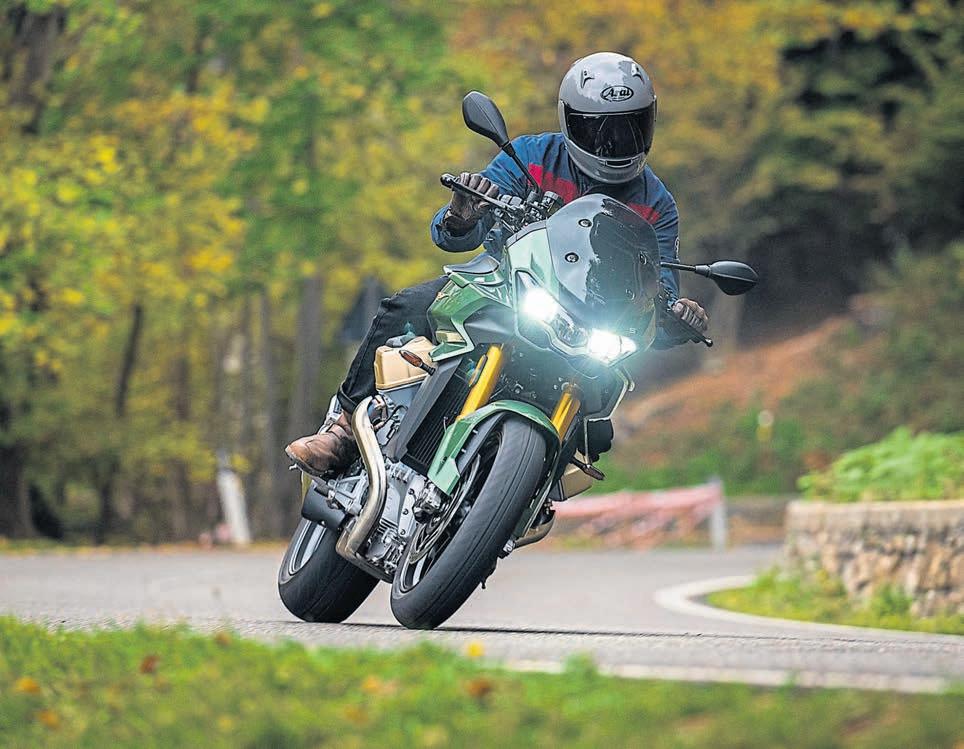
That’s changing, though. Suzuki’s newly-released GSX1000-GT and Kawasaki’s Ninja 1000SX hark back to the good old days – but if you’re after something a bit different, something sexy and Italian with plenty of prestige, there’s really only one choice: Moto Guzzi’s all-new V100 Mandello S.
The new bike’s a big deal for Guzzi. To celebrate 100 years of building bikes, CEO Roberto Colaninno told his engineers he wanted them to build something special that would help carry the factory into its next century.
And that’s exactly what they’ve done… creating a funky sport tourer with an all-new engine, semi-active aerodynamics, electronically-assisted suspension and a whole load of cutting-edge technology.
Thankfully, it still retains plenty of that inimitable Guzzi character – and even from afar, you’d have no trouble
attributing the V100 Mandello to the iconic Italian firm.
It’s a cracking looking thing in the flesh, neatly blending the comfort of a tourer with the aggressive stance and styling of a sportier machine (albeit one with a hulking great V-twin at its heart). You could almost call it a comfy naked, rather than ‘sport tourer’. It’s more compact than you’d think, although Guzzi actually reckons its riding position helps make it suitable for about 90% of the riding population.
I reckon that’s a fair assessment… there’re a couple of 6ft 5in lads on the ride, and they’ve reported no issues with the 815mm seat, slightly sweptback bars and relatively low-slung pegs – although there’s also a tall seat option for the bike, which the factory has said actually offers a slightly sportier ride, because you’re up over the front end a bit more.
There’s plenty of protection from the elements, thanks to an electronically-adjustable screen and those headline-grabbing semi-active aerodynamic winglets. You’ll have probably heard of the technology before (or something similar) in topflight racing. But Moto Guzzi’s not so interested in increasing downforce to keep the front end down. Instead, ‘the world’s first adaptive aerodynamics on a motorcycle’ is focused on protecting riders from the elements.
The system takes the form of a pair of wings which are mounted on the edge of the fuel tank – which automatically deploy themselves (in conjunction with the screen) depending on the rider mode selected and the speed you’re travelling at. They’re always out in Rain mode and will come out at 43mph in Tour mode (although you can also go into the settings and tell them to come out between 19mph and 56mph, if you prefer). Clever stuff. I admit, I wasn’t exactly blown away (ahem…) by them – but Moto Guzzi claims that they’re capable of taking 22% of wind pressure away from a

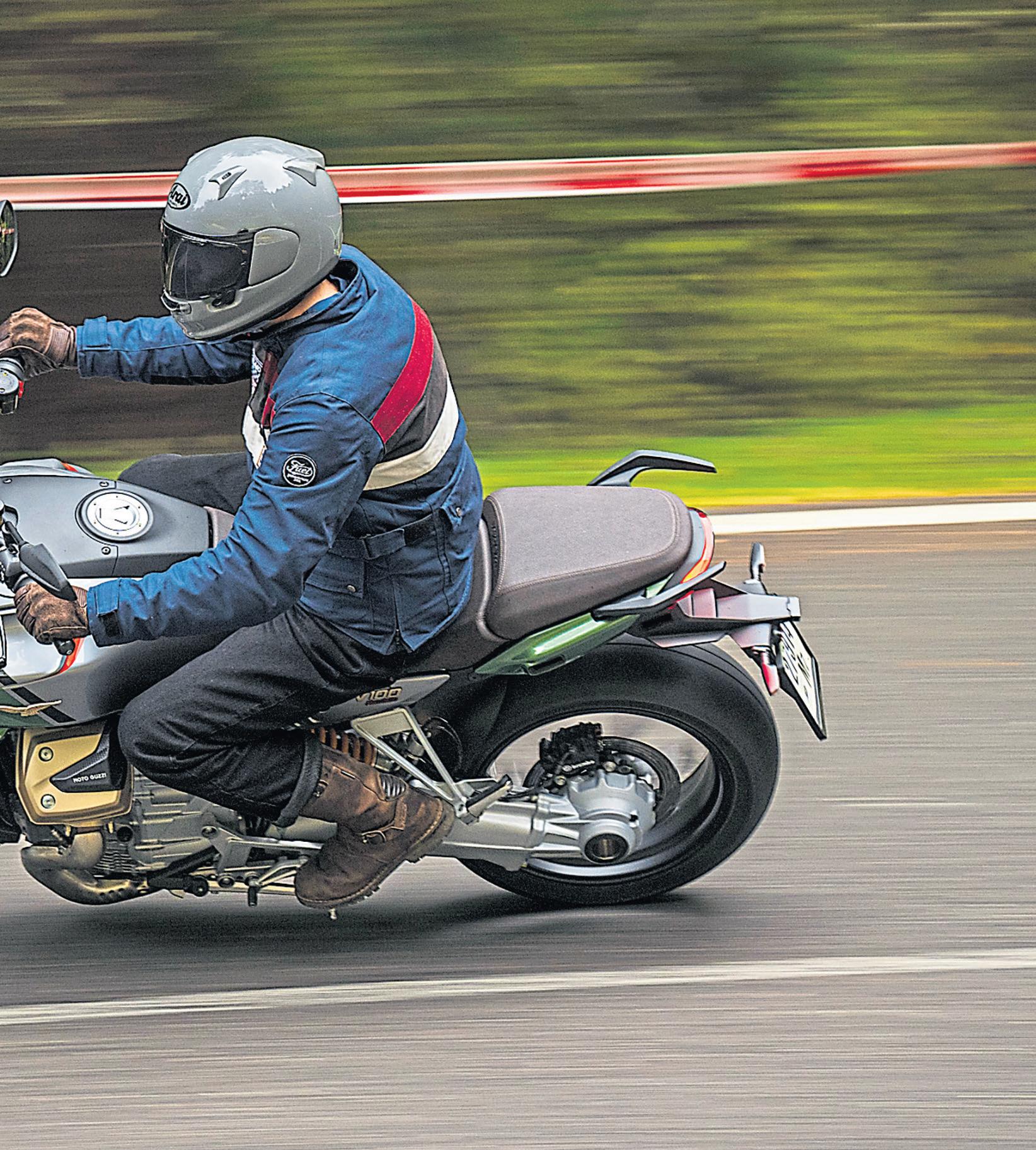
rider’s torso at motorway speeds. Sounds impressive, but in truth, I’ve never had any complaints about the amount of wind resistance on my torso – and a lack of prolonged highspeed miles on the test ride meant I didn’t really get a proper chance to put the new technology through its paces. That said, there’s no doubt it’s a comfortable place to be – and the wings, electronic screen, heated grips and plush seat all have their own part to play in making it so.
The innovations continue with the beating heart of the V100 Mandello: its 1042cc transverse-mounted 90-degree V-twin. So far, so familiar – right? Wrong. It might sound like a typical Moto Guzzi motor that you’ve seen a hundred times, but there’s actually a load of clever stuff going on to make it more compact,
more efficient and better for the planet (without compromising on outright performance or character).
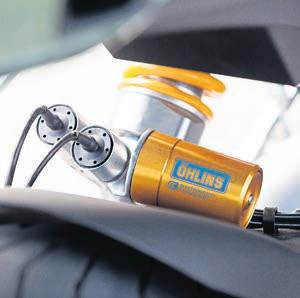
In addition to being the factory’s first liquid-cooled motor, the new 1042cc DOHC, 8v ‘compact block’ 90-degree V-twin makes use of a whole host of lightweight internals (to produce 50% less inertia than its older 1200cc).

That’s not all. Its cylinders have been turned 90 degrees (so the exhausts now exit from the side, not the front) and there’s a counter rotating balance crankshaft to help lessen the side-to-side rocking movement often associated with Guzzi’s transverse engine. But despite the changes, the engine’s still got plenty of character. It still rocks a bit, it still burbles when you fire it up, and it still lets out a deep war cry when you really give it some.

There’s a very healthy 77lb-ft of torque available low down in the rev range (over 80% is available at 3500rpm), which means it’ll comfortably and quickly pull away in almost any gear. There’s plenty of punch higher up, too, with peak power of 113bhp available at 8700rpm. While that might not sound like a lot, particularly when you consider the bike tips the scales at 233kg wet (and also that the
main competition makes marginally more power and torque), the Guzzi’s got nothing to worry about. It’s purposeful and characterful with a wide spread of power that’s plentiful enough to put a smile on the face of the most sensible of tourers (even two-up). Surprise, surprise. The Moto Guzzi’s engine is very good. Who’d have thought it…?
The six-speed gearbox is good, too. There’s a hydraulically actuated multi plate wet clutch (in place of the single plate dry clutch of old) which has been designed to try and reduce some of the free play found between gears, to help ‘low inertia and very rapid gear shifting’ – with the help of the up/down quickshifter which comes fitted to the S model as standard. The quickshifter is at its best when you’re making swift progress and either accelerating or decelerating hard, but it lacks a bit of polish and I found it to be a bit clunky between first and second when not in the sweet spot.
The rider aids continue in earnest with a full suite of electronics. The V100 Mandello is actually the first Moto Guzzi to be equipped with an IMU. It’s a six-axis number which works in conjunction with the rideby-wire throttle and ECU to track riding conditions and determine how
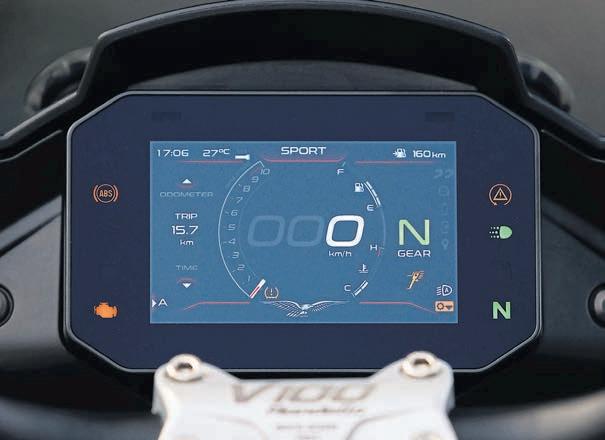
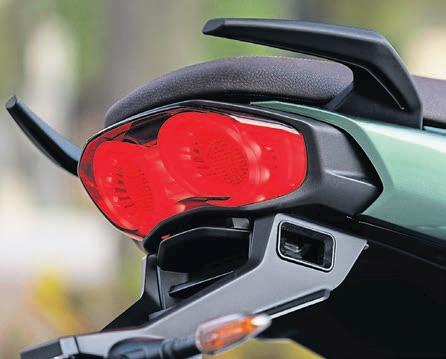
the bike will react to them. That’s made easier with the help of four distinct riding modes. There’s Tour, Rain, Road and Sport, which each offer a different combination of the three engine maps, four levels of traction control, two levels of engine braking, winglet activation and settings for the Öhlins semi-active suspension (only on the S model). There’s also the option to dial in further and fine tune the settings to specifically suit your riding. Oh, and there’s cornering ABS, too, which has been developed in conjunction with Continental. All good stuff, I’m sure you’ll agree. But in truth, it’s difficult to get under the skin of such a sophisticated electronics package in the short time offered on a launch ride. Sport mode proved a little too feisty for the drying twisties in the hills above Como, and I was happy with the amount of power delivered by both Tour and Road. It’s easy enough to operate using the lefthand switchgear and smartphonecompatible TFT dash. It’s not the simplest I’ve seen, but soon I was flying around the various menus and sub-menus with no trouble, changing riding modes and finding the perfect level of heat for the grips.


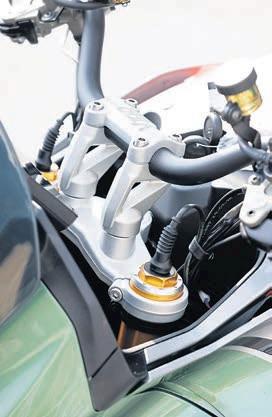


The bike stops exceptionally well, thanks to some quality Brembo M4 32 callipers, with twin 320mm discs up front and a 280mm disc out back. They’re far better than you’d expect on your usual touring machine, offering plenty of power and plenty of feel even while braking hard on slippery roads (after I misjudged the distance to the next hairpin turn). Credit must also go to the Pirelli Angel GT II tyres (which mount the 17in front and rear cast wheels) for having no trouble finding grip, no matter whether we were bombing over perfect Comoadjacent Tarmac, chewed-up cobbles through tiny towns or wet, leafstrewn, tree-lined back roads.

The S model’s Öhlins Smart EC 2.0 semi-active suspension system is another sophisticated bit of kit, which is capable of adapting its setting to road conditions and riding style on the fly. It has two modes as standard – Comfort (which is linked to the Tour and Rain riding modes) and Dynamic (which is linked to the Road and Sport riding modes) – each offering slightly
different states of tuning for the NIX fork up front and the TTX shock at the rear. The two suspension modes can be further fine-tuned using the OBTi (Objective Based Tuning Interface) and the TFT screen. It allows you to adjust braking support, front firmness and rear firmness with the press of a button. But if you want to carry a pillion or a load of luggage, you’ll have to go back to basics and twist a knob to set up the rear preload. It all works exceptionally well.

Taut and agile when attacking the corners and soft and spongy when barrelling through potholes, the suspension helps offer a near-perfect balance of pure performance and comfort. In fact, the V100 Mandello S handles well full stop, flicking into the tightest turns with ease and remaining composed under pressure. The turning circle’s not great though, with the bars hitting the stopper much sooner than you’d probably expect (particularly considering its upright riding position).
Guzzi’s done a cracking job with its newest machine. If you’re into covering big miles but you want something stylish and compact with plenty of character, then you’re going to love it. The S model might be pricey (the standard’s not exactly cheap either), but it’s a quality bit of kit that’s been built with plenty of care and attention and heart. If this is what the future of Moto Guzzi looks like, count us in.
A sophisticated 5in TFT dash courtesy of Aprilia is only the tip of the iceberg; the V100 Mandello’s kitted out with loads and loads and loads of technology, including aerodynamic wings, an electric screen, and semi-active suspension.

The Ohlins semi-active suspension is very clever. You can either modify the settings yourself, but it’s also capable of doing the job itself using the automatic mode which adjusts the front and rear compression and rebound damping.
Power: 140bhp
Torque: 82lb-ft Seat height: 835mm Weight: 235kg Fuel tank: 19 litres Price: £11,299
Replacing Kawasaki’s best-selling Z1000SX was no easy task, but the factory came up trumps with the better handling and better equipped Ninja 1000SX. There’s a reason it’s so popular. It’s a bloody good bike.

It’s more compact than you’d think, but Guzzi reckons it’s suitable for about 90 per cent of the riding population. There’s also a tall seat option for the bike, which the factory has said actually offers a slightly sportier ride, because you’re up over the front end a bit more.
In Rain and Tour modes, Moto Guzzi’s innovative semiactive aerodynamic wings automatically jump into action – and work with the screen to deflect wind and rain away from the rider.
Those cast wheels are gorgeous, aren’t they… But it’s the Brembo brakes that we’re most enamoured with. They’re a properly capable bit of kit, hauling the 233kg machine up without any trouble whatsoever.
Its 1042cc liquid-cooled 90-degree transverse V-twin is a lump of a V-twin motor, but it’s a little different to anything Guzzi’s done before. It makes a respectable 115hp at 8700rpm and 105Nm at 6750rpm.
Power: 150bhp Torque: 78lb-ft Seat height: 810mm Weight: 226kg Fuel tank: 19 litres Price: £12,499
The ‘dedicated’ sport tourer makes use of the much-loved superbikederived K5 999cc engine and adds a few goodies to make this a seriously tempting proposition for those who like covering big miles fast.







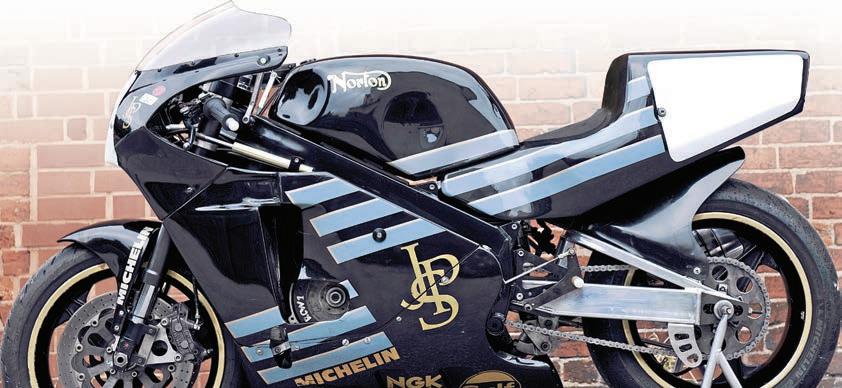















Riding within Wales isn’t all about the National Parks, with plenty of excellent riding in between, and winter weather can put them out of bounds anyway

WORDS and PHOTOS: Dave Manning
For this Winter Ride, focussing within Wales, I decided on starting from Oswestry, the town of my birth. Now, while the town isn’t actually in Wales, but a

Winter Ride. However, when I was born my sisters were both at school in Oswestry, and were both taught Welsh, so that’s close enough for me…
The plan was to ride across the country, heading west, to end up at the coast for the potential of
warming fish and chips. And, with it being in the colder half of the year, and with an awareness of how bleak the conditions can get when riding through Snowdonia or into the Brecon Beacons, the decision was made to stay away from the more remote areas and higher altitudes.

Where: Running from the border of Wales and Shropshire, and using a convoluted route west to the coast of Cardigan Bay. There are lots of options to veer off-route and explore, and a lot of industrial and cultural heritage to discover, too.
Description: There are some fairly rapid stretches of road on this ride, particularly the A470 south from Trawsfynydd, but the more remote stretches such as the B4391 and A4212 are narrower, have a higher population of sheep, and are less likely to have been treated with grit when the weather gets really cold. So it’s worth taking your time, and to enjoy the superb views.
Distance: 84 miles.
Time: Two hours if you’re non-stop, but six hours if you explore a little and stop for pictures!
Fuel: We fuelled up while still east of the border, with a petrol station on the A5 near Oswestry, but there’s a fuel station at the T-junction near Trawsfynydd, and in Dolgellau, but be aware that they may not be open on a Sunday.
Cafés: A regular haunt for motorcyclists is the café at the end of Bala Lake, although it was closed when we were there, but there are several in Bala town, and in Dolgellau.
Curiosities: While not actually situated on the route here, it’s only a short diversion to the racetrack at Tonfanau, just north of Tywyn, with regular race meetings throughout the year. Or to the fascinating Centre for Alternative Technology (CAT) just outside of Machynlleth.
The greatest issue in riding through winter is, with no great surprise, that of combatting the cold, although there is no excuse why you can’t stay warm in the 21st century. For my trip into Wales, aside from wearing my Keis heated jacket, I also tried out a pair of the Keis G301 ‘Three-finger’ gloves, invariably referred to by all who see them as ‘lobster gloves’. While it appears that they have just two finger ‘pockets’, these are
internally divided so each finger is kept snug and toasty, with reduced outer surface to minimise heat loss. The hydrophobic outer shell and waterproof membrane keep your pinkies dry as well as warm, and the design allows you to play out all your Star Trek fantasies – stay warm and prosper!
The G301 gloves are priced at £200, and more information is available from www. keisapparel.com


The middleweight adventure bike market has exploded, with a huge variety of bikes to choose from. We picked two from the more off-road side of the field, two from the road-adventure camp, and set off for the Yorkshire Dales.

This was the first one to arrive at the lock-up when we picked up the bikes for this test, so I had the first shout about which one to ride before the others got there.
I had ridden the Suzuki and Yamaha before, so I discounted them. Then it was just between the Moto Morini and the Aprilia. I wish I could tell you that I employed some careful consideration there, but I simply went for the one that I thought looked better: the Aprilia Tuareg 660.
As soon as I had made my choice, I sat on the bike, did a couple of little loops around the unit and was certain I had made the right choice. No matter how good the Morini was, it was not going to be this good!
The same admiration of the bike continued as we rode up to the Dales for the main part of our test.
I couldn’t believe how light the steering was, how quickly and accurately the bike turned, and what a lovely piece of engineering that 660cc parallel twin engine was. Whether zigzagging through towns or attacking A and B roads, the Tuareg was in its element. It was easy and effortless to ride, and the soundtrack from the engine kept a smile on my face all day.
The only time when I noticed a slight dint in the Tuareg’s armour was when we were riding on the motorways. What had felt like lovely light steering at slower speeds, turned into a slightly worrying light and vague feeling. It could be to do with the knobbly AX41 tyres that we had put on the bike because of the trail sections of our ride, but I found myself thinking that a steering damper would be handy. Still, dropping the speeds a bit seemed to help with that. Another speedrelated problem I had was the non-adjustable screen that became very noisy at higher speeds. Again, dropping the speed a little, the issue was fixed.
Riding around the Yorkshire Dales for three days was the perfect test of bike comfort, and the Aprilia fared a lot better than I had expected.
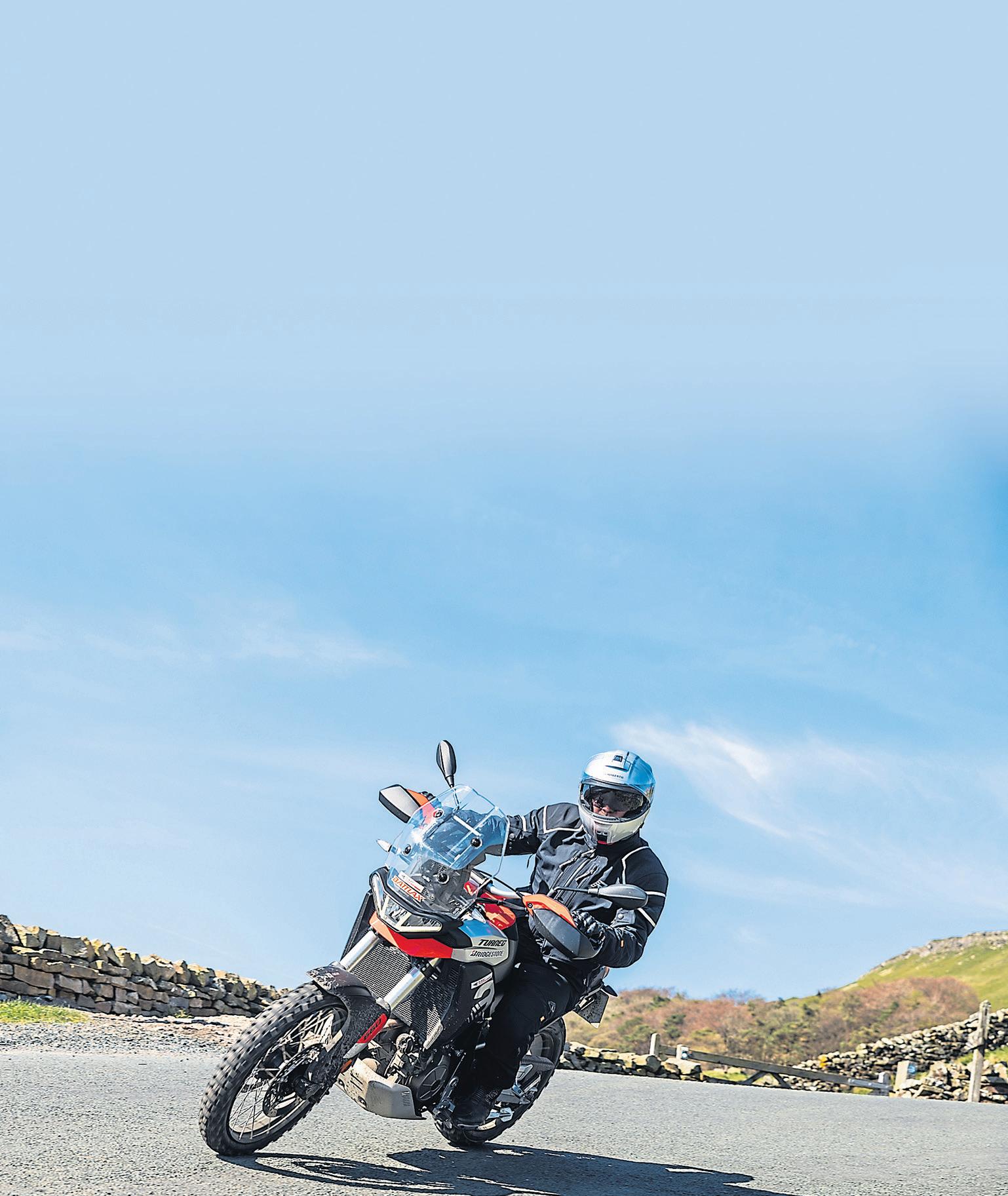
The riding position is one of the best that I have come across, with the seat, bars and pegs all positioned so perfectly to create a relaxed riding position for me that it felt tailor-made. The seat is much comfier than it looks, and long days in the saddle are easy.
The handlebars are nice and wide, helping further with that light steering feel and giving you plenty of leverage for fast turning – you wouldn’t believe that you are turning a 21in front wheel.


The Tuareg’s suspension is fairly soft, which helps with comfort, but can make the bike feel like it’s a little lethargic when ridden hard. For me this is fine as I would always take comfort over razor-sharp accuracy, but if you were going to do a lot of off-roading you might want to make some changes to get the most out of the 240mm travel.
In terms of tech, the Aprilia has a nifty TFT screen that shows you the ride modes, traction control, cruise control, ABS settings (which can be turned off), but as hard as I tried, I couldn’t find a fuel gauge. Strange.
I didn’t find that the ride modes made a huge difference, so apart from engaging the off-road mode when we left the Tarmac for some lanes, I didn’t feel like I needed to adjust anything. It all worked perfectly well without me fiddling with it.
Cruise control was a nice little bonus, too, making long stints on big roads that little bit more carefree.
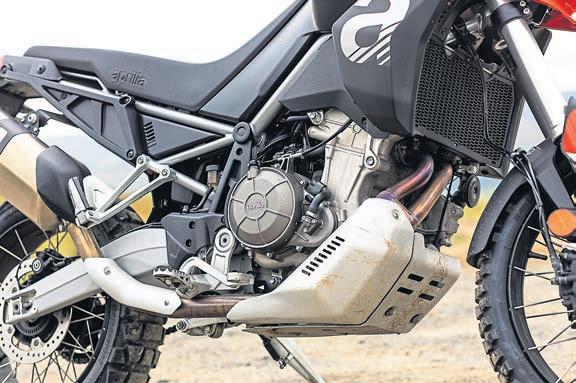
Price: From £10,600 Engine: 659cc parallel
eight
Power: 80bhp (58.8kW) Torque: 52lb-ft (70Nm) Transmission: Six-speed, slipper clutch, chain final drive Frame: Tubular steel frame and subframe Suspension: (F) Fully adjustable Kayaba 43mm forks, 240mm travel, (R) Aluminium swinging arm with fully adjustable Kayaba monoshock with 240mm travel
Brakes: (F) Brembo four-piston callipers, 300mm discs, (R) Brembo single piston calliper, 230mm disc. ABS Test tyres: Bridgestone AX41, (F) 90/9021, (R) 150/70-18 Wheelbase: 1500mm Seat height: 860mm Fuel capacity: 18 litres (3-litre reserve) Wet weight: 204kg Warranty: 24 months Contact: www.aprilia.com

While fashion is constantly changing, style remains and – from the eyes of this jaded hack – the X-Cape has style in bucket-loads.
While it may not be everyone’s cup of Oolong, the pseudo-Dakar look, with the humpty-backed fuel tank, low seat and full fairing, really appeals to me, especially with updates such as the sleek LED headlights.
Although the name does niggle a little, surely it should be S-Cape?
There’s nothing out of the ordinary when slinging your leg over the
845mm seat (a lower, 820mm version is available), and it didn’t take very long for me to realise that this was a rather pleasant place to be. The engine is the CF Moto version of Kawasaki’s ER6 motor, in a detuned state. As such, it hasn’t got the absolute power of the Kwak’s powerplant, but will therefore be near unburstable, regardless of mileage or the owner’s level of mechanical sympathy.
It does need revving to properly get a shift on, and to be kept above 6000rpm –which is where the airbox starts to make a decent noise, although it’s all over by 9000rpm.
The bottom end is a little gutless when compared with the other bikes on test, and the fuelling isn’t what I’d call perfect, but ridden in isolation there’s nothing wrong whatsoever, it’s just comparing it with bikes that have near-perfect fuelling. And, of course, the engine first saw production back in 2006, and engine tech and fuel injection management have come a long way since then… There’s a long throw to the gear lever, and it needs a positive action (rather than a subtle little nudge) as it’ll not select the next gear if you’re a little gentle. That’s no bad thing, and in conjunction with the engine characteristics, it actually feels close to the way that many Class 2 learner bikes do, which’ll be comforting with those for whom the X-Cape is their first ‘big’ bike.
However, when it’s tested alongside the Yamaha and Aprilia it does feel a little wanting, in several ways. The looks are, in my opinion, the best of the bunch here as far as pseudoDakar adventure bike styling is concerned – not as ready for hardship as the Yam, but certainly more prepared for rough and tumble than the Suzuki – but you’re not really looking at the bike when you’re riding (aside from in shop windows…)
The seat looks right, and is right, and only prolonged periods of motorway need a bum shuffle, and the fact that the pegs are nicely placed, with the option of not only riding on the balls of your feet but also shifting your heels on to the pillion peg hangers – and also even using the pillion pegs if you wish –means that there’s enough variation in seating position to keep you at least as comfortable as on any of the other bikes in this test.
The screen is pretty efficient, albeit noisy and, like the Aprilia, it is possible to find a quiet spot by tucking down behind the screen, but this is only comfortable for about half-a-minute, so fit ear plugs and put up with the noise and a bit of buffeting (a word that is far too close to a meal time where you help yourself to food from tables of sandwiches and crisps).

But the power, and the way that it is delivered, mean that you’ll have your work cut out if your friends have any of the other bikes in this test, as even the Suzuki (with its aging engine) can clear off ahead of the Morini. Although the handling is confidence-inspiring, you do need to keep the engine on the boil at all times.
Although Italian by name, and with design and development still within Italy, Morini is now owned by the Chinese Zhongneng concern, and while some folk are still thinking that Chinese products are of an inferior quality, the new Morini seems to be of a decent quality, although a British winter or two may show exactly how durable the products are.
But bear in mind that many of the parts – such as the fully adjustable Marzocchi forks, and the Brembo brakes controlled by a Bosch ABS system – are highquality parts on what amounts to a cheap bike. Okay, so the brakes are old tech Brembo, with axially-
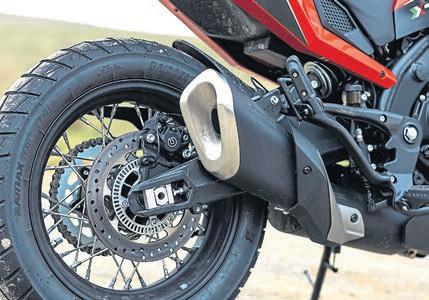
mounted sliding callipers and a physically small conventional master cylinder, but they are still good-quality components that raise the spec of the bike. And there’s backlit switchgear; a USB charging point; a really nice TFT dash; a full 7in in size with Bluetooth interconnectivity; while there are just two rider modes (thanks, in part, to the fact that throttle control is still by a conventional cable, and not ride-by-wire, this just means that the ABS is either on or off!); and heated grips (that the company website refers to as ‘heated knobs’).
Initially, the X-Cape seems a little outclassed here, although at £4000 less than the Aprilia, it’d be a miracle if it wasn’t. And, to be fair, when ridden in isolation, the Morini is a bloody good bike, and that ‘four large’ would pay for a lot of adventures. So, for a first dip into adventure bike waters for the 21st century Moto Morini and its Chinese supply chain, it’s an impressive offering.


Up until recent years the adventure bike market has mostly been all about the large-capacity offerings, such as the market-leading BMW R1250GS. And to a degree, it still is. But what if these don’t float your boat? Where do you go? What do you buy?

The middleweight section is growing fast, with some awesome machines on the market. One of the most interesting in this segment is the Yamaha Ténéré 700 – or the T7, as it’s often called. When we allocated the bikes for this test, I was given the T7 for a few weeks to find out what it was all about. I wasn’t complaining!
Adventure bikes have to have a compromise somewhere, and the T7 is aimed firmly at its off-road foundations; the minute you climb on you know you’re astride an offroad-based bike. It feels like an offroad bike from the off: narrow seat, wide and high bars and, of course, the Dakar-esque fairing arrangement.
Inside the Dakar fairing is a set of very basic clocks that have graphics like a game of snake on your Nokia 3310. But that’s all it needs to be as the whole bike is very basic. No traction, wheelie or slide control. Just a very raw motorcycle, controlled entirely by the skillsets of the pilot – there’s something quite endearing about that. An IT degree isn’t required to get the best out of this bike!
Although the seat is narrow and MXstyled, it’s actually more comfortable than it looks. The fact there is plenty of space to manoeuvre around helps with the repositioning to stay numb-bum free, as the two-hour ride up the A1 to get to the Dales proved. Once off the motorway, the T7 turned from a comfortable tourer into a back lane superhero. It is light, precise and flickable, despite the 21in front wheel. I can only imagine how good it would be with some 17in Supermoto wheels.
It may not have the ponies stored inside that its rivals have, but there’s more than enough, and the torque range the 689cc twin offers is extremely linear, pulling from 2000 revs all the way up the range which, in turn, reduces the need to regularly flick up and down the gearbox; massively helpful when riding tricky off-road sections.
We tackled some tricky, rocky, offroad lanes where throttle, clutch and brake control were a must. There is quite a large reach to the clutch lever, which was just about okay for me, but would limit short-fingered types. It’s nothing some aftermarket levers with a shorter span and more adjustability wouldn’t sort, though.
In terms of the throttle and brake, these worked in perfect harmony with no snatchy feeling from the throttle and no brake judder, which is a must for intricate off-road riding.

Ground clearance was adequate for where we were riding, and the T7 covered the route with ease.
Suspension is fully adjustable and makes the bike ride nice and smooth on the road. It soaks up most of what an average rider could throw at it while off-the-beatentrack. With some aftermarket off-road suspenders in it, this would be a serious weapon and one which you could live with as a pure Adventure bike.
Yamaha Ténéré 700
Price: £9900
Engine: 689cc parallel twin, l/c, eightvalve, dohc
Power: 72bhp (54Kw) @ 9000rpm
Torque: 50lb-ft (68Nm) @ 6500rpm
Transmission: Six-speed, chain final drive
Frame: Steel-tubed double cradle, cast alloy swingarm

Suspension: (F) Fully adjustable forks, (R) Fully adjustable shock
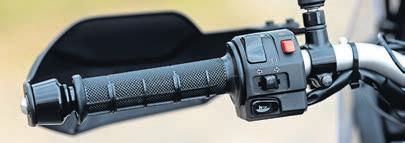
Brakes: (F) Twin 282mm discs, twinpiston ABS callipers, (R) single 245mm disc, single-piston ABS calliper
Test tyres: Bridgestone AX41, (F) 90/9021, (R) 150/70-18
Wheelbase: 1595mm
Seat height: 875mm
Fuel capacity: 16 litres Wet weight: 204kg Warranty: 24 months, unlimited mileage Contact: www.yamaha-motor.eu
All in all, this is a brilliant piece if kit, and ideal for the more off-road orientated Adventurer who likes to cover miles both off- and on-road no matter how short or great the distance. I’m very tempted to buy one, but I’ll wait to ride the World Raid version first, as that looks perfect…
A lot of people love the V-Strom 650. First launched in 2004, the venerable ‘wee-strom’ has had plenty of time to garner the affections of adventure-loving bikers who value accessibility, affordability and reliability over sharp styling, loads of power and the latest gadgets.
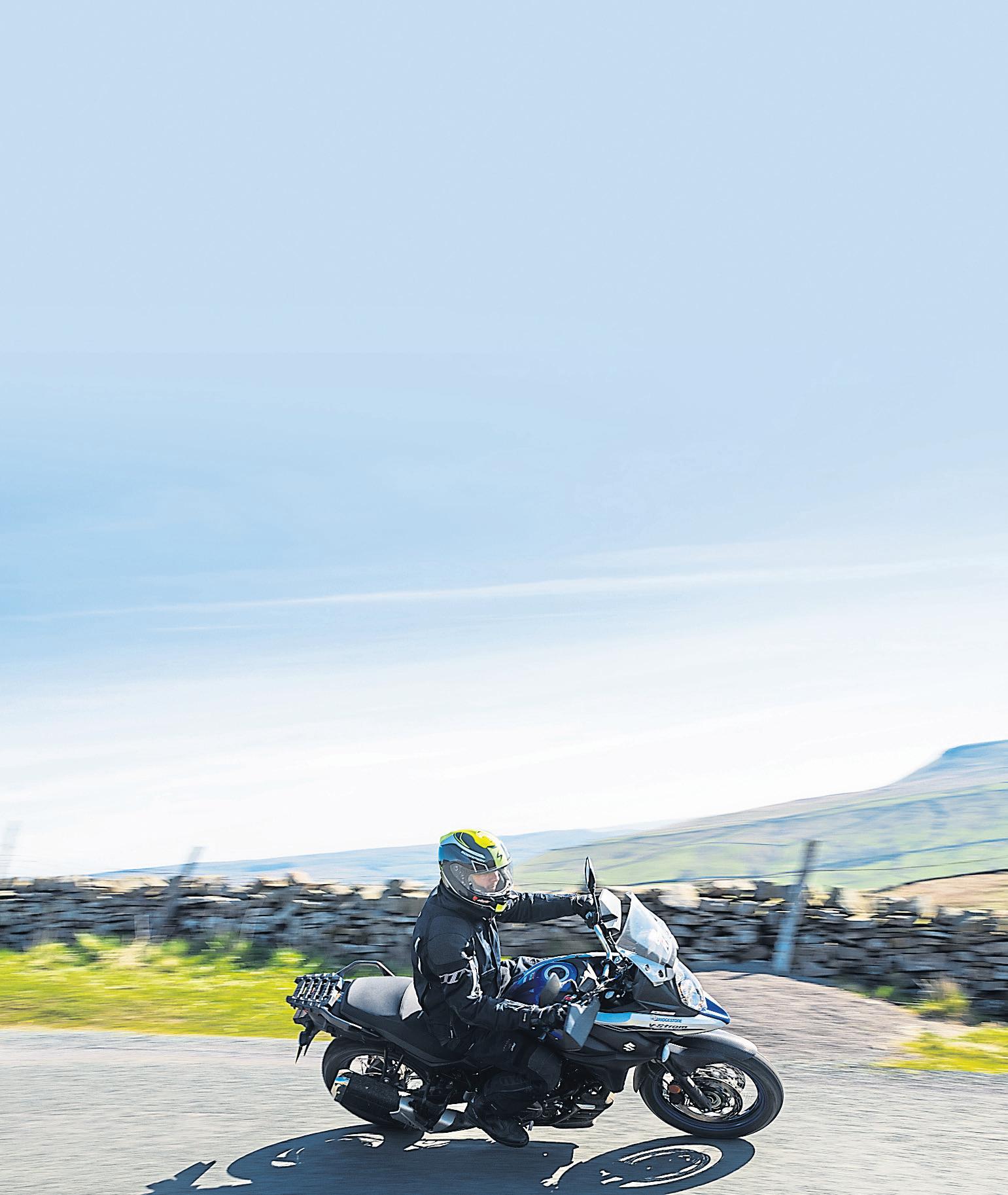
If it ain’t broke don’t fix it Powered by the same tried and tested motor as the SV650 and largely unchanged for several years (mechanically, at least), you could argue the V-Strom 650’s getting a little bit long in the tooth. You could maybe even argue that it’s a bit of a dinosaur in an increasingly overcrowded market in which other manufacturers continue to push the envelope with each new model and each passing year.

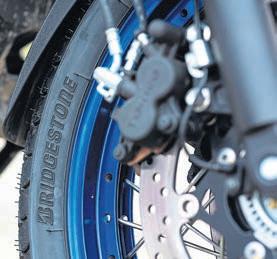
But when you consider its enduring popularity among back-tobasics bikers who aren’t interested in ‘keeping up with the Joneses’ in the battle for more power and more technology, it’s hard to fault this dinosaur for not worrying about going extinct.
Until relatively recently, the V-Strom 650 was actually your only real choice if you wanted a brand-new, truly middleweight adventure bike. There’s been a recent resurgence in the category, and nowadays the Suzuki’s got more competition than ever before – but they’re not really playing the same game. Sure, it’s an adventure bike, but it’s softer, more easygoing and more accessible than its competitors. That’s got to count for something, right?
When stood side-by-side with the Ténéré, Tuareg and X-Cape, it’s quite difficult to describe the Suzuki as a
looker. It has made progress over the years, with enough nipping, tucking and modernising to keep it fresh, but in truth it doesn’t have the same, sharp, modern Dakar styling as its counterparts. That’s partly because it’s not all that modern; while it does get fuel injection, traction control and ABS brakes, its non-adjustable front forks, rear link-type set up (which can be adjusted for preload only) and old-school analogue instrument panel hark back to a simpler time. Thankfully, the 650 XT (as tested here) does feature hand guards, spoked wheels, an engine guard and a rear guard – which help to give the impression that it’s a rugged and ready-for-anything adventure bike.
There’s also no getting away from its diminutive stance. When compared with the others, the seat’s lower, the pegs are higher and the bars aren’t as wide or as tall
While that might make it perfect for shorter or less experienced riders who want to get their feet on terra firma with ease, my 6ft 1in frame meant that things felt a little cramped when compared directly to the competition. That said, when you get the V-Strom 650 moving, you’ll soon forget about all that –because at its core it really is an excellent road bike.
That’s right. Road bike. I don’t want to get into the whole ‘what makes an adventure bike’ argument, but for me, the V-Strom 650’s relative lack of off-road prowess and more roadfocused ride (particularly when put up against the other three) means it’s a bit of a stretch to call this a true adventurer. It’ll pootle down lanes, and it’ll be alright on gravel tracks, but the standing position isn’t quite right, with the low bars and higher
pegs meaning I had to hunch up to get into any kind of workable stance. Thankfully, it more than makes up for it on the black top. Its unstressed V-twin motor is genuinely brilliant, delivering plenty of low-end grunt, while a throttle-happy right hand will have you fizzing along very nicely past the speed limit, all the way to its 10,000rpm limit and 120mph top speed.
The six-speed gearbox is smooth and precise, and there’s very little buzzing or vibration even as you press on. It really is a lovely set up – and while it might not offer earth-shattering levels of performance, there’s plenty in the tank to easily make overtakes and sit
at motorway speeds in comfort.
The handling’s very good, too. The chassis is superbly balanced and it’s light and agile and easy to flick around town, but super-stable in corners when the pace hots up, too. It just gets on with things with no grumbling – and although the suspension and brakes might be relatively basic, they perform perfectly well, too. It really is a lovely bike to ride; easy, assured and confidence-inspiring.
Despite its obvious limitations and some very tough competition, the Suzuki V-Strom 650 more than proved itself during our three-day,
Suzuki V-Strom 650 XT

Price: From £8699
Engine: 645cc four-stroke, liquid-cooled, DOHC, 90° V-twin
Power: 71bhp (52.0 kW) @ 8800rpm Torque: 45.7lb-ft (62.0 Nm) @ 6300rpm
Transmission: Six-speed constant mesh Frame: Aluminium twin spar Suspension: (F) Telescopic, coil spring, oil damped (R) Link type, coil spring, oil damped Brakes: (F) Twin 310mm discs, two-piston callipers and ABS (R) single 260mm disc, one-piston calliper and ABS Test tyres: Bridgestone AT41 / (F) 110/80R19M/C 59V (R) 150/70R17M/C 69V Wheelbase: 1560mm
Seat height: 835mm
Fuel capacity: 20 litres (4.4 gallons) Weight: 216kg Warranty: Two years (with the option to extend to three)
Service intervals: 7000 miles Contact: www.bikes.suzuki.co.uk
several-hundred-mile trip to the Yorkshire Dales. It flourished on the road, coming to life on the fastflowing and tight, twisty Tarmac we explored, arguably offering the best road manners of the bunch – and I have no doubt it’d happily keep up with bigger and ‘faster’ bikes on twisty roads.
With its tried and tested utilitarian design, excellent chassis and engine combination, and value-for-money price tag, it’s very easy to see why it’s so popular. I was actually very, very impressed. If you’ve never ridden one, you should. It might be just what you’re after.
+ Its road manners are impeccable
+ Tried and tested design; any kinks were ironed out long ago
+ Simple, straightforward with no unnecessary extras
– Cramped riding position compared to the others
– Lacking some of the technology of its competitors
– Not the best looking of the bunch… (though it’s all down to taste)
WORDS: Ross MowbrayThis was always going to be a slightly unfair test if you only look at the absolute performance of the bikes The Aprilia and Yamaha left the Suzuki and Morini eating the dust without really even trying too hard
But that’s just a part of what appeals to people in bikes. If you are not too bothered about the trail-cred of the bikes, or if you don’t want to get every last ounce of
power from them, the V-Strom and X-Cape are perfectly good bikes. You could argue that for a road adventure you don’t need anything more. And when you look at the prices of the bikes, you soon realise that you could do a helluva lot with the dosh you save if you go for the older tech.

Ridden in isolation, all of these bikes are thoroughly enjoyable and entertaining, it’s only when you ride them back-to-back that
you notice the strengths and weaknesses in high definition.
So, if you are looking to get a new middleweight adventurer, have an open and honest chat with yourself, and consider what you really want the bike for, then ignore what you just found out and buy the bike that moves your soul! They are all good, so you may as well go for the one that inspires you. Life is for living!









Tested (to
Shark helmets has always been one of my favourite brands. I’ve had various versions over the years, but mostly ‘flip-up’ as I like the option of being able to choose whether to use as an open face, or a full face.
It was the Shark Evo-One 2 helmet I was wearing when I was involved in a recent road traffic incident – not the normal way I would have preferred to test a helmet to destruction, but I’m afraid that was the way it panned out; this also applied to my bike, which ended up as a ‘cat B’ write-off This was all because a car driver, coming from the opposite direction, turned across the road in front of me, was in collision with my bike and catapulted me over the handlebars which resulted in me head-butting his windscreen, then ending up on his roof. If that wasn’t enough, he carried on driving until challenged to stop –at which point he
braked and shot me down the road like a torpedo, resulting in me hitting my head a second time.
The car driver admitted liability straight away, but it was that situation most bike riders dread and think: ‘It won’t happen to me.’ But it does, and you need to make sure you’re wearing decent motorcycle clothing whenever you’re on the road.
All my clothing, from my footwear to my head, suffered damage in the incident, but I have to say that I was more than impressed with the way my Evo-One 2 performed – especially given that I’d effectively done a double whammy by head-butting the car windscreen and the Tarmac in the same incident.
At first glance the helmet damage might look superficial, but looks can sometimes be deceiving, and any road safety organisation will be quick to advise you that once any impact has been made (even by just dropping it), it should be replaced –don’t put your own safety at risk, no matter what the circumstances. In my case, Shark’s Evo-One 2 performed admirably.
The Evo-One 2 helmet has been discontinued by Shark and
replaced by its new Evo range. Given how well the Evo-One 2 performed, it will be from this range that I’ll be sourcing my replacement – a new Evo ES model.
The Evo-One 2, however, is still widely available via most reputable helmet suppliers.

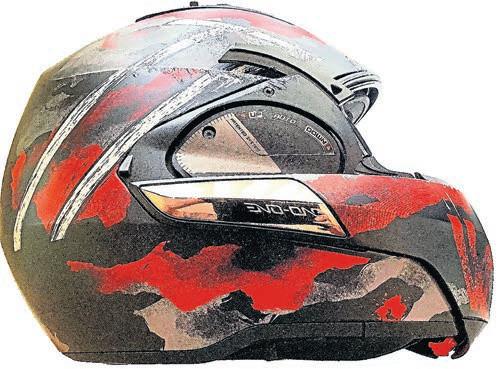
My experience didn’t end there, but just got more farcical, so at this point I’d like to say thanks to the guys from emergency care charity Lincolnshire
LIVES, the Horncastle Fire & Rescue Team, and the A&E staff at Pilgrim Hospital, Boston, for all the care they gave me. After undertaking a CT scan and X-Rays, the A&E team was amazed I managed to survive without any broken bones or other life-threatening injuries.
The ‘farcical’ part of my experience began at the accident scene.
An ambulance was called (at this point it wasn’t known if I’d suffered any head/neck injuries) but after two hours of lying in the road and not moving, a phone call was made to
find out how long it would be for it to arrive – only to be told that as there appeared to be no significant injuries (and due to the county experiencing a ‘critical incident’ scenario), a vehicle would not be coming.
So, I was bundled into my own car (my wife had turned up at the scene by now) and sent off to the nearest hospital – which was closed when we arrived. So we had to back-track, past the incident scene, to Pilgrim Hospital in the opposite direction.
Finally (and just to rub salt into my wounds), the car driver had admitted full liability at the incident scene – a scene the Police attended. So imagine my surprise when a week or so later I received a letter from the Police saying the driver was not going to be prosecuted.

My wife was furious and immediately contacted the Police to find out why. She was told that the officer(s) in attendance would contact me over the matter; that was around six weeks ago at the time of writing this article and we’re still waiting for that contact to happen…
The Evo-ES is a completely new modular design and my first impressions of it are good – I can’t wait to get back out on the road to try it out once my new bike arrives. At a quick glance it doesn’t look that much different from my old helmet, but with a modern twist. Visually, the only major difference between the ES and One 2 appears to be that it doesn’t seem to have the fittings to take a pinlock insert, but Shark tells me that the main outer visor is treated with an anti-scratch and anti-fog coating, so we’ll see how well that works under the right weather conditions. More about this helmet in a future Tried & Tested article…
Sometimes it all goes wrong when you’re on a bike. Mau was lucky to escape this one without injuring himself too badly, and it goes to show that quality kit is essential
With so much choice out there when it comes to buying riding kit, sometimes you can become ‘kit blind’ – so we’re here to help! Keeping up-to-date with the latest technology and kit is our job, so let us lend a hand by showing you what you should be looking out for when buying your next set of textiles and posing the questions that you should ask yourself before setting out on your mission of choosing them…


The Infinity 2 Pro is a laminated jacket with a detachable thermal liner, D3O protection at the shoulders, elbow and back all wrapped in an abrasion-resistant outer fabric. There are five air vents and a connection zipper for compatible trousers. Also laminated, the Colorado 2 Pro trousers feature an anti-slip section on the bum, D3O protectors at the knee, pockets for optional hip armour, air vents, and pockets. Option of short or regular leg length.


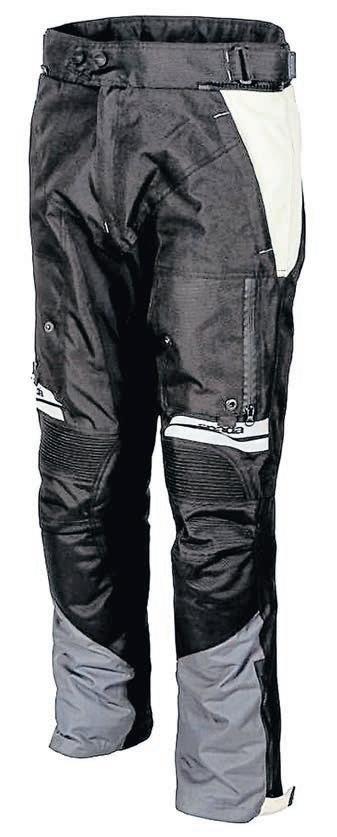



Spada’s Alberta range can be purchased separately, so if you’re on a budget you can pick and choose what you want. The jacket has outer fabric with hard mesh for ventilation, CE-certified five-piece armour, quilted detachable lining, adjusters and button closure collar. You can add the overjacket for waterproofing, gilet for warmth and bib for visibility. The trousers feature four-piece armour, mesh vents, adjusters, quilted detachable lining, reinforced panel at seat, accordion pleats above knee, and long and short connecting zip.
Would a textile jacket and a pair of riding jeans with some waterproofs you can throw over the top actually be better for the riding that you do? If you’re planning to be out in all weathers and put some serious miles on your bike, then textiles are a good option. If you tend to ride on a weekend and avoid the rain where you can, then you may be better with a mix-and-match set.
Set yourself a budget as to how much you’d like to spend, then look at the options within that price range. It’s very easy to get carried away and think an extra £50 isn’t that much, so setting an upper limit will help rule out choices that push the budget too much.
It goes without saying that elbow, shoulder and knee armour are a staple. You may want to look for textiles that come with/have the provision for chest, back and hip protectors. Check the standard of armour, too – big and bulky doesn’t always equal protective.
Modern tech fabrics are ‘up there’ in terms of their ability to protect you in the event of an accident. Do look for clothing that specifies it is abrasion resistant. Look closely and often you’ll see extra fabric section inserts on strategic places, e.g. knees and elbows.
Gore-Tex has become a household name and is synonymous with waterproof, yet breathable items. As a result, they’re very protective – and selective – as to who they work with as they want to maintain the high levels of quality expected with the brand name. As you’d expect, there is a price premium for clothing with Gore-Tex. If your budget doesn’t allow, then don’t worry as other waterproof membranes perform the same functions.
If you plan to ride throughout the year, then ideally you’d like kit that will be suitable for all weathers. Textiles that have a removable thermal liner are good as you can keep warm when needed, but it may be helpful to look for a jacket and trousers that also have vents for those warmer days – yes, we do have the odd one in the UK!
You could go for a ‘laminated’ jacket – which means that the membrane layer is bonded to the outer material of the jacket, instead of being a floating layer between the shell and inner lining. Benefits include improved breathability over nonlaminate items and better insulation as the cold is prevented from reaching your body. It also means that the jacket doesn’t become as heavy when raining as it doesn’t absorb the water, instead it simply runs off the outer shell as opposed to being soaked through to the liner. On the flip-side, however, laminated items are more expensive than non-laminated.



One of the many advantages of riding a motorbike is that you can make better progress than cars because you can overtake other vehicles easier. But overtakes are still not easy, even when you are on a bike, and they require a lot of skill, knowledge and attention to do them safely. We talked to Ryan Decarteret, national operations manager and coach at Rapid rider training to get some tips on how to take our overtaking skills to the next level.
MB: What makes overtaking so tricky?
Ryan: Gathering information takes on a new level of complexity when overtaking as we take into account factors such as the driver of the overtaken vehicle, who may not be aware of our presence, and could change speed or direction at any time. There may also be vehicles behind us considering overtaking. It all happens very fast, too. At national speed limits closing speeds with opposing traffic could be 120mph or higher. And there is always a risk from cars emerging from side roads or laybys that are not expecting to see a motorcycle on the ‘wrong side of the road’. With all that in mind, our goal is still to gather as much information as we can, as early as we can.
MB: So, how do you do it?
Ryan: In an ideal world, we would plan to arrive at an overtake at the exact moment the opportunity opens up. This may involve using acceleration sense to adjust the closing speed on the vehicle ahead so that we arrive just at the right moment to maintain momentum and effortlessly pass, we call this a Momentum Overtake. The alternative is that we are already behind a vehicle and are waiting for an overtaking opportunity to arrive, this is called Staged Overtake. Both of these scenarios demand a different approach.
MB: Can you talk us through a Momentum Overtake?
Ryan: A Momentum Overtake involves timing our approach to maintain the majority of our speed as we arrive at, and pass the other vehicle. This requires us to see the vehicle very early, assess its speed, and look way beyond the vehicle to identify other hazards we need to be aware of. As we get closer, we adjust our position to achieve maximum view of the road beyond the vehicle to be overtaken, and adjust our speed by using throttle control to time our approach. Having ensured the road is clear of other hazards, we move smoothly out to the offside lane to optimise our view and give maximum
clearance from the overtaken vehicle, and we complete the overtake. It’s worth noting that there are many occasions where, in order to extend the view, the rider would position to the offside a long way before arriving at the vehicle to be overtaken.

MB: What about a Staged Overtake?
Ryan: If we are already in a following position behind the vehicle we wish to overtake, the technique for overtaking is different. There are several stages we must work through to get the overtake completed, including positioning for view whilst behind the vehicle, then moving to the offside of the road to extend the view prior to the overtake, and finally completing the overtake.
MB: How do you position for view whilst behind the vehicle?
Ryan: If we are already in a following position behind the vehicle we wish to overtake, our goal is to position the bike so that we can collect as much information as possible about the road ahead, and identify the first safe opportunity available to us. Many riders miss opportunities because they have closed the gap on the vehicle to be overtaken at the expense of the best view of the road ahead. Especially
with large vehicles or on bends, riding too close reduces your view significantly. It also restricts the rider’s flexibility to control their speed, forcing them to match that of the vehicle ahead. It is far better for safety and progress to maintain more distance, maximise the view, have more flexibility over speed, and maintain a better safety margin.
On the way into bends, a rider wanting to make progress will be anticipating the possibility of an opportunity opening up after the bend, and will want to be ready to go at the earliest safe chance. A significant benefit can be achieved by maintaining a good distance behind the vehicle ahead and moving the bike around on the approach to the bend to find the earliest view through. For example, on a left-hand bend, this is often achieved by keeping to the nearside of the lane and looking through the inside of the vehicle ahead to gain an early glance of the road opening up.
MB: What do you need to consider about moving to the offside? Ryan: Once an opportunity has presented itself, the rider should move out to the offside lane without immediately closing on the vehicle ahead. A pause in the offside position allows the rider to validate
the opportunity. If the road is clear, the rider passes the vehicle giving as much clearance as possible; if it is not, the rider can safely return to the following position.
MB: And finally, how do you best complete the overtake?
Ryan: In both a Momentum and Staged Overtake, the rider should use the width of the available road to keep well clear of the vehicle being overtaken. From this position, they should aim to ride in as straight a line as possible back to their target return spot, rather than swoop out and swoop back in. A great overtake should appear smooth and effortless with none of the drama of a poorly planned one.
Riders often feel rushed into the overtake once they have moved to the offside. This stage of the overtake should be seen as positioning for view, NOT a commitment to overtake. Getting used to using the width of the road to extend the view into the overtake is good practice. Separating this from the necessity to commit is essential. Likewise, once we have passed the vehicle we are overtaking, if it remains safe and legal, we should not feel obliged to rush to return to our ‘own side of the road’ if remaining in the offside position offers advantages to safety, stability, progress or view.
Ryan is a passionate motorcyclist, Rapid national operations manager and coach with a background in surveillance and covert police riding, with around one million miles of riding experience (and he says he’s still learning).
Founded in 1997 by a group of ex-racers and current police riders, Rapid set out to deliver a fresh approach to rider development with its own, relaxed, no-nonsense approach to coaching. No formality, no student bibs, just passionate riders being coached by the most highly qualified professionals in the business – and having fun. The company claims to offer the most comprehensive and advanced rider coaching available in the UK. www.rapidtraining.co.uk

There’s more to overtakes than first meets the eye. Planning is key.
Try to keep the lines as straight as possible. No swooping!







Think old school Beemers and you’re pretty much assured you’re going to be looking at an air-cooled flat twin, right? Well, think again because for more than a decade Bayerische Motoren Werke GmbH (Bavarian Motor Works Ltd) offered a range of triples and fours that were liquidcooled. And if you think that was avant garde for the traditionalist German firm get this – the motor was laid flat on its side!
As BMW navigated the 1970s it was clear to senior management that the firm needed a flagship model that took it beyond the traditional flat twin set up. Honda’s Gold Wing had illuminated a different route and in 1977, engineer Josef Fritzenwenger unveiled a concept bike based around a PSA-Renault X-Type engine from a Peugeot 104 car. The low C of G afforded by the prototype matched BMW’s ethos and with input from the car division BMW developed motors following the Peugeot’s basic shape, but were equipped with double overhead cams and digital fuel injection. BMW suddenly had a totally new bike for the first time since the R32 was unveiled in 1923!
The new K series played to BMW’s strengths insomuch as everything aft of the engine was familiar territory and the power unit was instantly understood by those members of the car division that had been moved across on to the project. Despite tipping the scales just shy of 250 kilos, the K100 was still was lighter than its competition, i.e. the Kawasaki GPz900R, Yamaha FJ1100 or Suzuki GSX1100EF. Journalists were suitably
impressed with the eight-valve DOHC motor and its Bosch fuel injection – another first for BMW.

Ultimately the K100 would appear in four guises: the naked K100, the K100C that sported a cockpit fairing, the LT luxury touring and the sports K100. Subtle tweaking of the final drive ratios in the bevel box gave each model slightly different performance characteristics.

BMW’s brave move into the world of OHC four-cylinder engines delivered a motorcycle unlike any other and this differentiated it from the Japanese fours whilst still playing a similar, if not identical, game. This was a singularly unique take on a fast and competent four-pot sports tourer and something no one has managed to better to this day.
Soon to be nicknamed the Flying Brick, the bike’s unique design was rapidly appreciated by both owners and service teams. Arguably even easier to work on than the old flat twins, the entire engine could be worked on in situ without the need to remove it from the frame, and it’s a key facet of the design that appeals to home mechanics today. The cylinder head, fuel injectors and top end can be accessed from the left of the bike with the crankcase and crankshaft accessed from the right – no other modern classic has ever bettered this aspect of the early Ks.
BMW foresaw a market for a smaller version of the new K engine and developed the K75 triple which, in essence, is the K100 with one pot removed and 120-degree crank installed. There are other mechanical and structural differences with the K75, but one of the big bonuses is the smoothness of its engine. Where the four can still be a little buzzy, the
three has a mellower feel to it and despite being down on power, proved to be popular.
The K100 subsequently received a 16-alve head and would later go on to power the polarising K1 sports with its all-encompassing bodywork which even covered a lot of the front wheel. The final iteration of the K concept ran from 1997 to 2005 before being swapped out for an all-new design much more in line with contemporary Japanese designs.

What did the K series triples and fours achieve if BMW subsequently walked away from the concept?
Well, something rather important actually – there were customers out there that wanted a bike with the famous roundel badge but didn’t automatically buy into the traditional bikes.




The airhead flat twins morphed into oilheads; BMW launched the F650 (there first single for decades); the K series continued developing through to 2004; and an 800 F series parallel twin was launched. Latterly across the frame fours (as per Japan) appeared and even an inline six. Those early Ks certainly broke the mould!
Quality, quality and, again, quality; the early K series machines were a huge gamble for BMW and they simply had to be right. They are well built; have a relatively decent spares back-up; are easy to service; have decent handling; and, perhaps most importantly, look different to everything else.
Finding an unmolested one may be your biggest challenge now! There was a time when the early Ks were unloved and unwanted …well, until
Seals can fail leading to oil in water and water in oil.
If parked up for a long while the engines can be a little noisy. Long-term rattles are possibly output shaft, sprag clutch and alternator cush drive.
Main gearbox seal can leak oil into the clutch.
Drive splines need to be lubricated regularly. Bevel box should be have no free play.
Check for corrosion and rotting out before it collapses.
Generally good but gauges and clocks can play up.
Some smoke from the exhaust when the bike has been parked up on the side stand isn’t unusual but it shouldn’t persist.
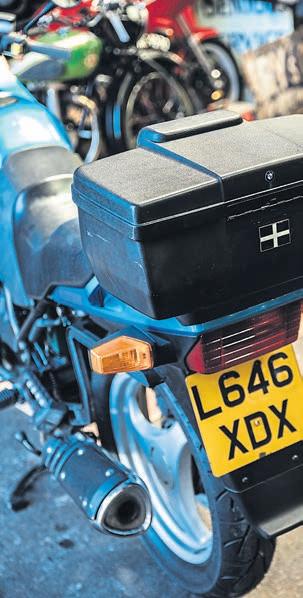


An early K series Beemer has to be the cheapest way to get into classic BMWs period. Different but not awkward, unusual but not weird, special but not expensive – there’s nothing else out there like them. And if you wanted reassurance about just how strong those motors are, know this… K100 motors are used to great success in classic sidecar racing!
the hipsters started turning them into so-called café racers. The K100s start from as little as a grand and, even with higher mileages on such, still make for a decent machine. £2000 will buy you a low mileage example with owner service history. Arguably you probably don’t need to go much beyond £3500 for a fully pannieredup example that’s only really just run in at 45,000 miles. If the K75 catches your eye, and many owners prefer the triple over the four, £2500 will buy you a minter. All things being equal when you purchase an early K, buy on condition, not on mileage.

Many of you might not know much about Kymco, but you’d be wrong to think it’s not a serious player. The Taiwanese firm has actually had a long and illustrious history, including nearly 40 years of partnership with one of the biggest names in the game: Honda.
Kwang Yang Motor Company was founded way, way back in 1964. It started out manufacturing for Honda Japan, and over the following 20, 30 and then 40 years, that relationship only grew and grew – with Honda becoming a significant shareholder of Kymco right through to 2003, when Kymco decided it was time to separate and focus on its own brands. And that’s what it’s been doing ever since, while building scooters and ATVs for Kawasaki and supplying engines for BMW in the background.
In the UK it’s been best known for its mobility scooters, ATVs and smallcapacity bikes and scooters, but more recently it’s upped the ante with some seriously capable maxi scooters, including the well-respected Yamaha TMAX-rivalling AK550. And using that tried and tested platform as a base, it’s now created the CV3, a three-wheeled machine that’s perfectly placed to tempt car drivers to don a helmet and

experience the joys of motorcycling. That’s because the new Kymco CV3 can be ridden on a car licence (providing you passed your test before January 19, 2013).
I’ve ridden the current crop of threewheelers – Peugeot’s Metropolis, Piaggio’s MP3, Yamaha’s Tricity 125 and 300, and Niken (though the last one requires a full licence to ride) – and always had a great time, so I couldn’t wait to swing my leg over Kymco’s latest creation.
While I recognise it’s probably not going to be to everyone’s taste (particularly those with a preference for two wheels), I reckon the CV3’s a cracking looking thing. Sharp lines, an aggressive, almost adventure bike-style front end, a big screen with plenty of space for my long limbs. The only thing that lets it down is the little hump-cum-backrest on the seat which seems like an unnecessary addition. The finish is good, too –and there’re some nice goodies as standard, including a keyless ignition system, a smartphone compatible dash (which is kitted out with Kymco’s own ‘Noodoe’ navigation system), and cruise control. There’s not as much room as you might imagine under the seat, but you’d have no trouble stashing a jet or open face helmet with room to spare.
Sat bolt upright with its locking mechanism activated, the CV3’s quite an imposing thing to behold. I’m 6ft 1in and could happily get both feet on the floor, but I noticed a couple of the slightly shorter lads on the launch looking less than comfortable. It’s partly because it’s so chunky, and partly because you can’t bank it over to get at least one foot flat on the ground, but actually once you get used to the three wheels and locking the steering as you stop, I’m sure even the shortest of riders would have no qualms about jumping on. That locking system is a bit of a strange thing to get used to, though…
It’s a clever bit of kit which works to keep the bike upright when you’re not on the move, but I kept forgetting that I needed to lock it back into position before getting off That’s more about habit than anything, and I soon got in the swing of things after being nearly caught out by the top-heavy front.
Thankfully, that weight completely disappears as soon as you get moving, and experienced riders will have no qualms throwing it around in the twistiest of bends and turning around in tight spots. It really is very easy to ride.
The motor’s good, too. I’ve spent a fair bit of time with the AK550 on which the CV3 is partly based, and although it doesn’t have quite the same urgency as the sporty maxiscooter (mostly due to its increased weight), it’ll make swift enough progress for stress-free overtakes

Could Kymco’s new CV3 be the machine to convince the car driving masses that there’s more to life than four wheels?
While the CV3 isn’t exactly laden with the latest kit, the smartphone compatible dash and integrated turn-by-turn navigation system is a nice touch. As is the cruise control.

It might be a little bit unconventional, but I reckon the CV3’s a stylish bit of kit that stands out from the crowd.
There’s so much grip available up front thanks to those two front wheels. It finds traction in places where standard bikes would falter.
and provide enough punch for a satisfyingly spirited ride.
It stops well enough, too – smoothly and safely – thanks to a pair of Kymcobranded two-piston callipers up front which are activated using the usual right-hand lever. There’s also a singlepiston rear brake which is operated by the lever on the left bar and also a slightly novel foot brake, which operates both the front and rear simultaneously. I couldn’t quite get to grips with it, but I expect it would be quite useful for those who may be making the transition from car to CV3.


The suspension’s good, and the two front wheels definitely help the scooter to bound across rough terrain with less upset than you’d expect for your conventional bike or scooter. There’s plenty of grip, too. We rode
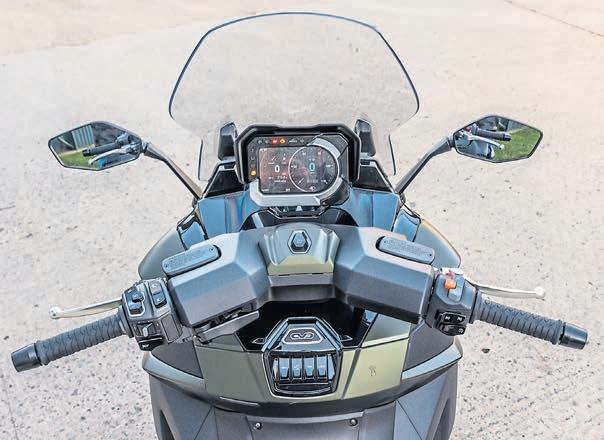

Price: £11,999
Engine: 550.4cc liquid-cooled, DOHC, 4-stroke, 8V, in-line twin
Power: 38kW (51hp) / 7500rpm
Torque: 52Nm / 6000rpm
Transmission: CVT
Suspension: (F) Telescopic forks (R) Unit Swingarm Brakes: (F) 270mm disc (R) 260mm disc Wheels: (F) 110/70-13 x 2 (R) 160/60R-15
Fuel tank: 15.5 litres MPG: 55mpg (claimed)
Seat height: 795mm
Weight: 265kg Contact: www.kymco.co.uk
the CV3 across all kind of roads, from mud-strewn back roads to perfectly surfaced A-roads and it lapped up the lot no matter how hard I tried to catch it out. Even if one of the front wheels loses traction on a manhole cover or a small patch of gravel, there’s another one on hand to keep things in check. It really does work.
The CV3 is a cracking bit of kit. Although plenty of you wouldn’t be seen dead on a three-wheeler, there’s no doubt that there’re lots of reasons why it’s well worth considering if you’re in the market for an all-rounder that’d be happy churning it out on the daily commute, doing some touring two-up, and everything in between. It would make riding even in the darkest depths of winter a doddle and inspire cornering confidence among the less experienced. If you’ve never ridden something with two wheels up front, I really would encourage you to head along to your closest Kymco dealer and give one a go. Even if you decide it’s not for you, I reckon a lot of you will be surprised about how much fun you can have.
If you're a car driver considering making the leap, then I'd implore you to take some basic training before jumping aboard. Although you're legally allowed to swing your leg over and crack on, a CBT course would do no end of good and help keep you safe out on the road.
It’s easy to get cocooned from the elements thanks to the massive screen and chunky bodywork.
The CV3’s a lovely place to be. I didn't get all day in the saddle, but I’m confident I could cover hundreds of miles without any aches or pains.
There's plenty of punch from the AK550-derived 550cc twin engine, despite the fact it’s got to lug around a whopping 265kg.
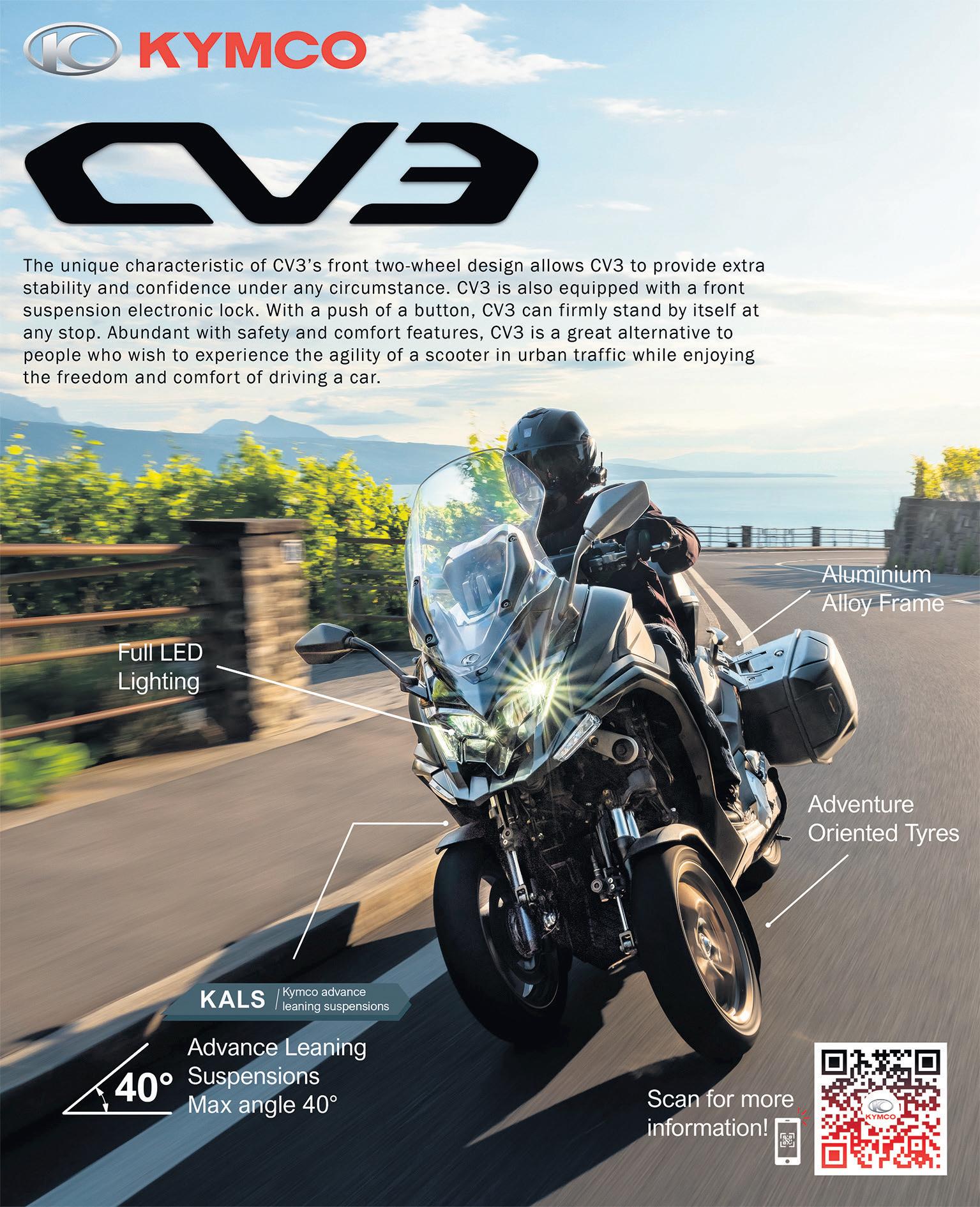
A new electric superbike from Finnish firm Verge has just been revealed – and it boasts some seriously impressive performance stats, and an eye-watering price...
It’s that time of the year again, when the Consumer Electronics Show rolls around – and as usual there was some seriously cool machinery on display, including this funky battery-powered superbike from Verge Motorcycles.
You might have heard of Verge before. The company’s been about for a few years now, slowly realising a small range of electric roadsters (which began to make it into punters’ hands last year). But now it’s stepping things up a notch with the introduction of its highestspecification bike yet: the Verge TS Ultra.
On paper it’s an incredibly capable bit of kit, with the factory claiming its newest ride will kick out a massive 1,200Nm
of torque and a production-superbikerivalling 201bhp. It’s also expected to reach speeds of 124mph, manage up to 233 miles on a single charge, with a battery which can be topped up from zero to 80 per cent in as little as 25 minutes. Impressive stuff, right?

Like the rest of its range, Verge’s TS Ultra is centred around a futuristic hubless design and rim-mounted motor, which helps it stand out from the crowd in the increasingly crowded electric motorcycle market. And with a commitment to either making its own parts in-house or sourcing from ‘top-ofthe-line European manufacturers’, should help give potential customers confidence
that the bike’s a serious bit of kit for proper bikers.
The only problem is the price. The TS Ultra’s €44,900 price tag (which is just shy of £40,000) puts it in direct competition with Ducati’s bonkers but brilliant (and very beautiful) Panigale V4 R.
That is not the bike you want to be up against – and it’s difficult to imagine too many bikers opting for the Verge given the choice, no matter how good it actually is. If you had the money, which one would you choose?
Cake’s first pedal-assisted bike comes fitted with a 250W motor which is restricted to just 16mph. But with the Äik being capable of covering over 200 miles when you kit it out with the three 750Wh batteries, and also having the ability to lug about 80kg in cargo (60kg on the back and 20kg up front), we’re expecting to see plenty of these utilitarian bikes hard at work on busy city streets in the not-too-distant future.

If off-road riding’s your bag, you’re going to love the look of the carbon-framed VMX08-S from Velimotor.
It tips the scales at an impressively light 47.5kg, thanks to its small 2.88kWh battery, 5.5kW motor and carbon fibre swingarm, frame and handlebars. But it’s no toy, as it has a claimed top speed of 62mph and is good for a maximum range of 68 miles. No news yet on whether it’ll make it to the UK, but with its non-carbon VMX12 available for £4,595, we’re hopeful it might be on the way soon.

American firm Huck Cycles has just announced a new addition to its electric motorcycle line-up for 2023. The stripped-back Stinger looks to be the perfect tool for commuters with a penchant for retro scrambler styling (even if there’s no thumping single cylinder motor at its heart). It kicks out 4bhp, has space for a couple of 3kWh batteries and is capable of covering 65 miles at its 45mph top speed.

 Welcome to Watt Bike. The electric market’s getting bigger and bigger – that’s why we’ve introduced this standalone section that’s dedicated to all things electric. We’ll be bringing you news, products, guidance, tips, tricks and, most importantly, reviews of the latest and greatest electric bikes, scooters and pedalecs to come to market every single month.
Welcome to Watt Bike. The electric market’s getting bigger and bigger – that’s why we’ve introduced this standalone section that’s dedicated to all things electric. We’ll be bringing you news, products, guidance, tips, tricks and, most importantly, reviews of the latest and greatest electric bikes, scooters and pedalecs to come to market every single month.
Considering switching to an electric scooter for the daily commute? The Segway E110S could be just what you’re looking for.

I’ve spent a reasonable amount of time on electric machines over the last few years. I’ve ridden the expensive stuff, I’ve ridden the cheaper stuff – and generally, I’ve been pretty impressed. And yet, there’s been a lot of derision from ageing motorcycle and scooter riders about our imminent electric future, and while concerns about infrastructure and energy consumption are entirely valid, that’s no reason to dismiss an entire category of machines right off the bat. After all, they’ve got two wheels and a motor, so they can’t be all bad.
Whatever your opinion, electric is here to stay, and as a result there’s an ever-increasing abundance of choice depending on your budget. On one side you’ve got brands like Energica who are building high-end, raceready motorcycles that’ll set you back close to £30,000. And on the other you’ve got a selection of commuteroriented, small-capacity machines that won’t break the bank. That’s where Segway comes in.
Yes. Segway. The very same firm that made its name building those funky leaning two-wheelers is now getting into the world of electric bikes. They’ve got a pretty substantial range available across the rest of the world, but for now we’ve got our hands on one of the first to come into the UK: its E110S moped.

First things first, I reckon it’s a great-looking little thing. Simple, straightforward and unashamedly modern. It is compact, but then again it’s ‘only’ a moped, and although not the roomiest ride, I doubt anyone would have any grumbles on their daily commute. There are a few neat little features, including a clever keyless start-up system (although you can just use a key if you prefer), a surprisingly spacious front cubbyhole, and an absolutely massive amount of underseat storage (a whopping 27 litres in total). That’s because the battery is stashed discreetly under

Voltage: 48V- 30AH
Battery capacity: 1440Wh
Battery weight: 11.5kg
Range: Max. achievable range up to 75 km* (WMTC range: up to 47km for the 25km/h version)
Charging time: Approx. 4 hours for 100%, 3 hours for 80%
Rated power: 350W (25km/h)
Maximum power: 1500W
Maximum Torque: 88nM
Brakes: (F) Hydraulic disc brake with 220mm disc (R) Hydraulic disc brake with 180mm disc Tyres: (F) 80/90-12, tubeless tyre (R) 90/80-12, tubeless tyre
Suspension: (F) Hydraulic forks (R) Twin shocks
Wheelbase: 1345mm
Seat height: 770mm Weight: 91kg
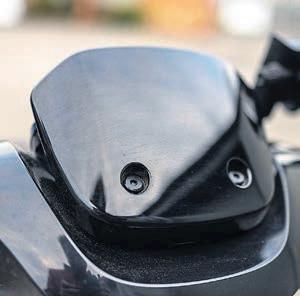
the running boards. It’s actually quite a clever bit of design. Most electric scooters I’ve ridden compromise storage by stashing the batteries under the seat, but Segway’s kept the weight nice and low, balanced the bike and offered enough space to stash your lid, some waterproofs and a lock in one fail swoop. Top marks. It comes kitted out with an antitheft system which uses an integrated 4G-enabled SIM and GPS to allow you to track the scooter’s location. There’s also a smart security system which detects any irregular movements and sends notifications directly to your smartphone and, if your scooter is locked with a battery inside, pushing, moving, or accessing the vehicle will trigger the alarm system. Clever stuff. It is worth mentioning that you’ll get two years of 4G subscription when you buy the
scooter, but after that runs out you’ll have to pay for your own.

In town the E110S is the perfect companion. You’re not going to be winning any races, but with a couple of horsepower and 27mph to play with, you’ll be able to make swift progress through busy streets and get the jump on traffic at the lights, and there’s enough power to zip out of busy junctions. What more could you ask for? It’s less fun out on the open road, but this scooter isn’t designed for whipping along A-roads. It’s an out-and-out city commuter and it deserves to be judged as such.
There’re three separate ‘rider modes’ which offer varying levels of speed and battery consumption. Clever use of these can help to preserve the life of the bike’s battery
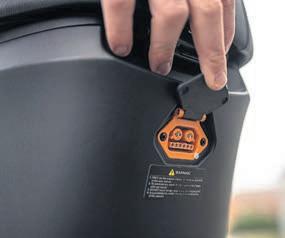
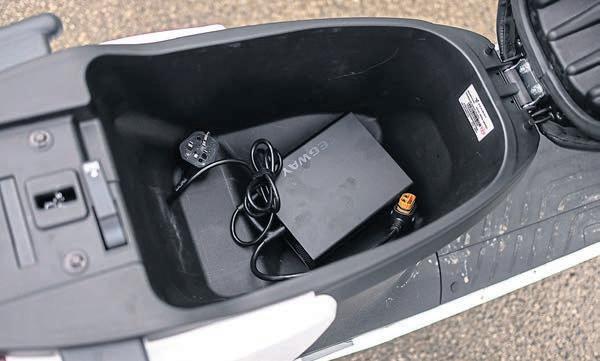
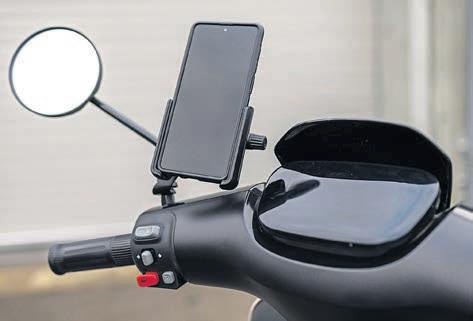
and get over 40 miles from a single charge. There’s also a Smart Battery Management System which monitors the amount of power, controls the charging speed and prevents the battery from over/undercharging. Speaking of which, a full charge will take about five hours from start to finish. It’s not particularly swift, but it does mean you’ll have plenty of time to top up a fully drained battery overnight or during your day in the office. And you can either charge the battery in situ, or you can whip it out and carry it to your closest socket.
It stops well. It’s by no means the most sophisticated machine I’ve ridden, but there’s plenty of bite to
haul the lightweight little machine up in a hurry thanks to the hydraulic disc brakes at the front and rear, though you’ll have to be careful not to lock up the back wheels under really aggressive braking.
The suspension’s fairly basic but is more than up to the job of keeping the E110S in check across the chewedup Tarmac across our towns and cities. And there’s enough poise to make whipping in and out of traffic and performing turns in tight spots a pleasure. The Segway E110S is great fun to ride and I thoroughly enjoyed my time putting it through its paces. Its acceleration is impressive considering the size of its motor; it
offers plenty of range for an inner-city commute, and the removable battery makes it easy to charge (providing you’ve not got to carry it too far). Okay, so it’s probably not the best equipped scooter on the market, but there’s enough good stuff going on to make it well worth its £2500 price tag. It’s infinitely cheaper than the cost of an annual rail pass in a larger city, and I know how I’d sooner get about. What about you? Do you agree?


If you’re looking for an affordable, economical and environmentally friendly scooter to squeeze through city traffic, you could do a lot worse than checking out the new Segway E110S scooter. It’s got a lot going for it, from its massive underseat storage and its built-in anti-theft systems, to its confidence-inspiring handling and smooth power delivery.






The infamous winter bike event has been running in North Wales since 1962. Inspired by the German Elefantentreffen, the rally is an annual pilgrimage for thousands of hardened bikers who can think of no better way to spend a wintery February weekend than riding to Wales and kipping under canvas.

Organised since its inception by the Conwy Motorcycle Club, the Dragon is a truly special event – and it’s surely one for the bucket list. Tickets go on sale in late September and sell out fast, so if you’re tempted, you’re going to have to wait until next year to get your hands on that elusive ticket. And even when you do, you won’t know exactly where you’ll be going until the very last minute On the day you’ve got to ride to a checkpoint for the final instructions on where you’ll be spending the night. Sounds fun, right? We’re going to be there this coming February, though thankfully we’ve got our heated kit ready and charged, not like this lot back in the 60s.
■ When is it? Second weekend in February
■ How to get in touch? Visit: www conwymotorcycleclub.org.uk
■ How much is it? You can join the Conwy MCC for £15 and tickets for the Dragon Rally cost £28 per person



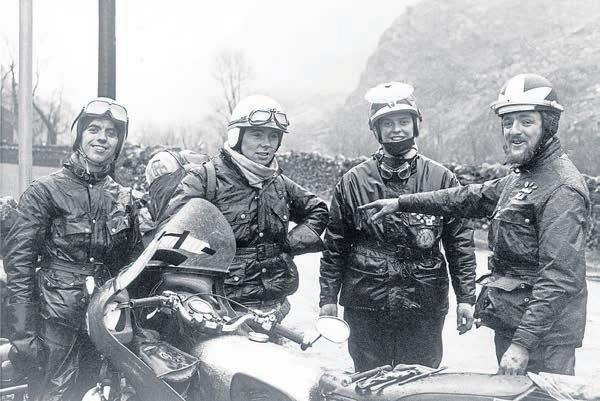

The first TZ500 aka YZR500 aka OW19 had been drawn up as early as 1971 and very firmly embraced the technologies utilised on the roadgoing YDS7 250 and YR5 350. In fact the bike was almost a pair of water-cooled 250s with two separate crankshafts and their respective crank pins set 180 degrees apart.
Despite being one of the first commercially manufactured fourcylinder two-stroke race bikes, the 500 (and its 700 big brother) were actually remarkably conventional in most aspects.
Liquid cooling was always going to be a must-have given Yamaha’s intense experience some years earlier
with the like of the RA31 and RA31A 125cc fours. The consistent cylinder head and exhaust port temperatures thus achieved released significantly more power.
Where the new motor deviated from convention was the utilisation of the then radical reed valves situated between the front face of the carburettors and the rear of the cylinder heads.
Like most great designs, the reeds valves were elegantly simple. A pair of thin, flexible metal plates were sandwiched between a V-shaped block liberally ported to aid air/fuel flow with a pair of stiff pressings that limited the maximum deflection of the said reeds. In essence, these ‘sprung flap valves’ (for want of a better description) were only opened and actuated when the corresponding piston rose, thereby
creating a vacuum within the inlet tract. As soon as the piston began to descend the vacuum abated causing the reeds to close, thereby preventing any fuel/air mixture being pushed backwards through the carburettor. At its most basic level the reed valve immediately prevented blow-back which squandered power but there were much greater benefits conferred by the set up.
The reeds allowed Yamaha to open up the inlet ports to a substantially greater degree than might otherwise be possible beforehand. In turn, this facilitated significantly improved crankcase filling which, in turn, boosted power output.
In theory, at least, any theoretical obstruction with the inlet tract should have had an impact of maximum power, but with the motor hurling out more than 100bhp Yamaha’s R&D
guys reckoned they had a few horses in hand to play with!
The reeds also had another advantage in that they conferred a relative degree of flexibility to the engine. Finnish rider Jarno Saarinen sampled two OW19s with and without reeds fitted and found the conventionally ported version was far too peaky in comparison.

The 100bhp power output put the 500 up there with the likes of the much smaller twin-cylinder MZ race bikes of a decade earlier in that the motor was delivering 200bhp per litre. This was a substantial achievement for a 500cc, four-cylinder motor, given the much greater levels of internal friction – and the results weren’t only due to the new reed valves. Yamaha had used the knowledge acquired in its motocross endeavours to further enhance gas flow and power delivery.

Carefully considered cylinder head designs allied to seven ports in each cylinder – inlet, exhaust, four transfers and a gulley of Z port in the cylinder wall – was all highly advanced stuff for the time.
The bikes were shaken down in Japan over the winter of 1972/73 ready for the coming season, with Yamaha’s official entry into the 500 class announced in February. At the opening race Jarno Saarinen won with Hideo Kanaya third, both on the previously unproven OW19s – Yamaha had arrived!

The VJMC – run by motorcyclists for motorcyclists. For membership enquiries only Tel: 01454 501310





Email: membership_vjmc@yahoo. co.uk Address: PO Box 1949, Yate, Bristol BS37 0BX Office hours: Mon-Thurs,10am4pm (please leave a message)




















































































ARIEL Square Four 1950, recommissioned 11 years ago and used every year, very nice usable classic and becoming a nice collector piece, £15,000. Tel. 07801 502033.
BMW K1200R Sport, 2007, 35164 miles, FBMWSH, ESA, ABS, Fender extender, hugger, Remus can, crash bungs, centre stand, heated grips, 2 keys, garaged, 2 owners, MoT due 30/05/23, Ventura luggage negotiable, £3450 Tel. 07703 619748.
DUCATI MONSTER 696 October 2009, 13,237 miles, three owners, FSH, original manual, both keys, 12 months MoT from July 2022, within last 500 miles air filter, spark plugs, new battery, fork oil, new chain and sprockets, timing belts, wheel bearings, fork seals, steering head bearings, £3500 Tel. 07889 733115.
KAWASAKI ZX6R600 Ninja, Termignoni titanium rear sports exhaust, Dunlop Sportmax rear tyre, new Michelin Pilot Sport front tyre, recent clutch, spark plugs, air filter, oil & K&N oil filter, needs some bodywork attention & chain & sprockets, good engine, very fast bike, no leaks, been used daily until recently garaged, starts first time and rides without fault, new bike forces reluctant sale, no MoT, have lost the V5, hence price, open to offers £850 Tel. 07398 891924.
NORTON 500T 1952, matching numbers road registered, £7000 Tel. 07919 064123. Lancs.



KYMCO X-CITING 2021, 71 reg, 5000 genuine miles, FSH, no winter use, 400cc, maxi scooter, in blue, garaged, new scooter forces sale, two keys, ex tyres Honda quality, offers, £4399. Tel. 07784 499299.
HONDA Africa Twin XRV750, original oil cooler, etc condition, £25 Tel. 07749 558220. Cheshire.
BMW R800 Mono gearbox for spares and repairs, £50 prefer collect-heavy.BMWK1100frame, V5 reg, 1996, £75, collect only.

Loads of K11 parts-short engine block-crank/pistons/rods, £50, tell me what you need project left overs Tel. 07704 831089. North Somerset, J20-M5.
TRANSALP 700 mirrors original chrome, £25 pair. Original standard screen, £20. Touring screen MRA X screen, tinted, £40. Haynes Manual, £10 plus p&p Tel. 07786 101211.
BMW K1100 need cam buckets 2.75 require five and 2.70 require two, have other larger sizes if you need to swop out Tel. 07704 831089. North Somerset J20-M5.
ASHY real leather motorcycle jacket, size 48 colour, black, excellent condition, £100. Tel. 07958 441132. Norfolk.
GRIFF JENKINS STORY by Mortimer Senior MCN Annual 1975, Honda CB250N Haynes Manual, Honda NC30 Manual Haynes, It’s a Triumph, Ivor Davies, £5 each Tel. 07974 822880. West Midlands.
SUNBEAM S8 1954, rebuilt, 1984, all original wheels and reg number, good order call for more info, £4500 Tel. 07932 652136.
Suffolk.
GREEVES Sports Twin Roadster, 250cc, V5C, Moorland blue, alloy mudguards, paddle hubs, new tyres, correct seat, good tidy useable British lightweight, ‘The Choice of The Expert’ excellent condition, £4000 Tel. Alan 01268 735135. Essex.
BMW R1200GS 2013 LC model, 49,000 miles, 2nd owner, everything works as it should, has ESC, ASC, ABS, engine modes, heated grips, tyre sensors, FSH plus many extras, £5700 Tel. 07930 338804.
BSA B40 1962, pre 65 trials bikes, full rebuild, alloy rims, stainless spokes Cub hubs, frame coated, alloy tanks, ready to trial, £4000. Tel. Dave 07583 532153. Staffs.

HONDA CBR600 Streetfighter, excellent condition, currently Sorn, £975. Honda seat for SS50 or small Honda, £25 Tel. 07510 674950. West Midlands.
HONDA CB250 Nighthawk, N reg, 1996, 58,000 miles, MoT till November 2023, used regular for last 10 years back and forwards to work, reliable and economical, low seat high, comes with rack, £750 Tel. 07857 211146.
HONDA HORNET 600cc, 1998, very good condition, Sorn, new tyres, battery brakes, fork seals, £1600. Tel. 01432 265726.
MATCHLESS G80S 1955, original paintwork, good tyres, luggage rack, leg guards, Digital regulator, gel battery, new Lucas SR magneto winding and wiring loom, new spare tyre and leather panniers included, £5450 ono Tel. Bob 01303 264972.
SUZUKI 1127L 1990, good condition for year all OEM panel’s showing 20,000 miles, brought before lockdown for something to do, rides as it should great power the best model of slingshot, £5000 ono Tel. 07774 932264.
TRIUMPH THUNDERBIRD 2002, 900, green, gold, 11,400 miles, immaculate, new coils, good tyres, chain, Deluxe seat, screen, saddle bags, good starter, runner, no rust, corrosion centres stand carrier, £6000 Tel. 07434 513161. Lancashire.
TRIUMPH SPRINT 2003, 18,528 miles, good runner, very clean, just too big for me now, £2500. Tel. 01646 602298.
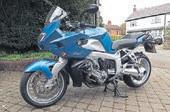
DUCATI Multistrada, 2003, 1000cc frame with V5, £450.
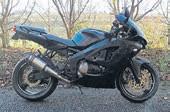


Plus lots of other spares for sale: Ducati 900SS, 2004, forks, £100. Ducati ST2 various spares for sale. Ducati Monster 600 engine for sale, £345 plus other parts. Garage clear out of lots of Ducati spares Tel. 07930 473221.
Staffs. Email. thinktank1150@ gmail.com
KAWASAKI Verseys 1000, 2016, front and rear sprockets, 16 tooth, 42 tooth, as new, only used for 300 miles, £25 Tel. 01502 568828. Suffolk.
CLASSIC MOTORCYCLE wanted any make or age from a box of bits to a mint machine British or Jap decent price paid Tel. Colin 01514 470147.
SUZUKI Burgman, 200cc, scooter must be low mileage and excellent condition, top price paid for the right bike Tel. 07778 742954. Staffs.
WANTED folding aluminium bike ramp, one that will bolt onto rear internal of my van, preferred size I.R.O. 2400 L, 1000 W, my location Larcs, 35 miles west of Glasgow can collect. Tel. 01789 750863. Scotland
HELMETS bargains Caberg Justissimo GT white, large, brand new, £55. Noland N87, white, large, brand new, £55 Tel. 01513 349674. Wirral.
HONDA THE WINNING YEARS £15. Honda The Complete Story, £10. Nazi Isle of Man TT, 1939 Victory, £12. Stanley Woods
1st Motorcycle Superstar, £20. History Clubmans TT races, 1947-56, £20, all new Tel. 01484 663007. West Yorks.
KAWASAKI JACKET TT leathers in green and white to match bike, with Kawasaki ‘K’ on the shoulders, size 42”, not scuffed or been down, shoulder and elbow armouring, £80 Tel. 01516 069983. Wirral.
YAMAHA
KAWASAKI Z1300 1977 to 1980 parts carb model starter motor ignitor unit fuse box, switch gear, tank badges, fuel tap, Kawasaki Workshop manuals, gasket tool kit, other parts available Tel. 01543 370720. Walsall.
ABBA BIKE STAND with fixing kits for Kawasaki ZXR750 and ZX-6R ninja, (fixing kits for other bikes available for Abba), little used, £50. Tel. 01516 069983.
MOTO GUZZI V35 Nevada, 1994, 13,800 miles, small screen, rack/backrest, pannier bags, engine bars, Hagon shocks, MoT, side and center stands, vgc, £2200 ono Tel. 07913 032864. Email. moorend4@hotmail.com Yorkshire.
SUZUKI BURGMAN, 2015, 400cc, dark grey, FSH, recent tyres, belt and rollers done at 16,000 miles, nice condition, long MoT, one owner no winter use, Givi box included, £2750 ono. Tel. 07784 499299. South Yorkshire
KAWASAKI KLR650 Tengai, 1989, complete rebuild from the ground up, full engine rebuild new paint, very nice usable classic, £3250. Tel. 07801 502033.
YAMAHA RD200 1981, 13,000 miles, tax & MoT exempt, used regularly, always garaged, good condition, history, £3000 Tel. 07732 582851.

MOTO GUZZI accumulation sell of V50 850T-T3 Californian etc late spoke wheels, Agostini seat unit sell off as one lot, offers, Benelli L/h side panel 500L, pair of early Krauser panniers. Tel. 07833 806288. Essex.
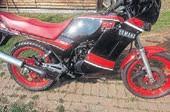
SUZUKI GS250 1982, frame complete, Honda CG125, 1982 engineandmanypartsTel.07951 099354. Southend-on-Sea.



SUZUKI GSR1052 1986 to 1990 engine carbs, ignitor unit coils, pickups other parts available, sensible offers Tel. 01543 370720. Walsall.
APRILIATHECOMPLETESTORY 2000, Mick Walker. Ariel Post War Models, Bacon. The Yamaha Legend 1979, Macauley. Honda Goldwing Portfolia, £10 each Tel. 07974 822880. West Midlands.
BSA GOLDSTAR singles, £20.
BSA ISDT Golds Maudes Trophy, £15. British Racing Motorcycle, £15. Panther Single, 1950, £10.
MZ Motorcycle Mick Walker, £17.50. Haynes Military Jeep, 1940 onwards, £15 all new Tel. 01484 663007. West Yorkshire.
MOTORBIKE BOOKS: 17 of, Harley Davidson Classic British Bikes Encyclopedia Motorcycles Classic Motorcycles Ultimate Motorcycle Hot Bikes History of the Motorcycle, 14 hard backs, 3 soft back, good condition, £20 the lot Tel. 01482 898930. Yorks
ONE PAIR Hepco & Becker panniers with frame/locks/keys, excellent condition, £200 ono. One large Givi top box with base plate, vgc, £70 ono Tel. 07913 032864. Yorkshire. Email. moorend4@hotmail.com
TRIUMPH TIGER Sport 1050, 2018, crash bars, top box and racks, handguards, Sat-nav bracket, cool covers, seat cover, exhaust, tail pipe, genuine parts, £400 ovno buyer collects Tel. Steve 07969 181499. Cheshire.
























